Physical Address
304 North Cardinal St.
Dorchester Center, MA 02124
Malignancies of the sinonasal tract are rare. They account for less than 10% of head and neck cancers, with an annual incidence of 0.5 to 1.0 per 100,000 people in the United States. The nasal cavity is by far the most common site for neoplasia of epithelial origin arising in this region, followed by the maxillary antrum and ethmoid air cells. Tumors of the frontal and sphenoid sinuses are exceedingly rare. However, the exact site of origin of many advanced tumors often is difficult to ascertain because of the anatomic contiguity of the paranasal sinuses and because a significant number of tumors may involve more than one site at the time of initial diagnosis. The distribution of primary tumors of the nasal cavity and paranasal sinuses is shown in Fig. 5.1 .
More than 80% of neoplasms arising in this region are of epithelial origin, and the remainder arise from the bone cartilage and soft tissues. Approximately 25% of all sinonasal tumors are benign. Benign epithelial neoplasms include squamous papillomas, inverted papillomas, adenomas, and other rare lesions. Squamous cell carcinoma is the most common malignant tumor, followed by carcinomas of minor salivary gland origin (adenocarcinoma, adenoid cystic carcinoma, and mucoepidermoid carcinoma), melanoma, and esthesioneuroblastomas. Although they are rare, a wide variety of mesenchymal tumors can arise in the sinonasal cavity, including benign lesions such as osteoma, ossifying fibroma, fibromyxoma, and angiofibroma; malignant lesions such as chondrosarcoma and osteogenic sarcoma; and, less commonly, soft-tissue sarcomas. The histologic distribution of malignant epithelial tumors of the nasal cavity and paranasal sinuses is shown in Fig. 5.2 .
As with the remainder of the upper aerodigestive tract, smoking is a predisposing factor for the development of sinonasal squamous cell carcinomas. Moreover, squamous cell carcinomas may also develop from preexisting inverting papillomas in up to 10% of cases. Other etiologic factors for sinonasal malignant tumors include exposure to wood dust, nickel, and possibly chemicals used in leather processing, although the precise carcinogens have not yet been identified. Transcriptionally active high-risk human papillomavirus (HPV) has more recently been detected in a significant proportion (25%) of patients with sinonasal squamous cell carcinoma, more commonly in nonkeratinizing carcinomas. Similar to other sites, HPV-associated cancers have a favorable prognosis.
Because the paranasal sinuses are air-filled structures with significant potential space, sinonasal neoplasms rarely produce symptoms at an early stage. Sinonasal tumors may be discovered incidentally on radiographic imaging performed for other reasons, or during surgery for presumptive inflammatory sinus disease. Symptoms usually develop as a result of obstruction of the involved sinus or nasal cavity or when the tumor breaks through the walls of the involved sinus and produces symptoms relating to the local invasion of adjacent tissues or bleeding (epistaxis). Thus the majority of patients present with advanced stage tumors ( Fig. 5.3 ). Even when symptoms from sinonasal tumors are present, they may be interpreted as innocuous, such as nasal obstruction, epistaxis, or symptoms of obstructive sinusitis, including facial pain and congestion. Accordingly, a high index of suspicion should be maintained, especially in older patients with unilateral symptoms. As tumors extend beyond the bony confines of the sinonasal tract, they can affect other structures and cause swelling or a mass in the hard palate, upper gum, gingivobuccal sulcus, or soft tissues of the cheek. Loose teeth, anesthesia of the skin of the cheek and upper lip, diplopia, and proptosis are signs of local extension of disease beyond the maxillary sinus. More advanced tumors may present with trismus consequent to extension into the masticator space with infiltration of the pterygoid muscles. Posteriorly based sinonasal tumors, especially those in the sphenoid sinus, may present with anesthesia in the distribution of the fifth cranial nerve or paralysis of the third, fourth, or sixth cranial nerves with associated eye symptoms or ophthalmoplegia. Anosmia is a common symptom in patients with esthesioneuroblastoma, but it can occur with any advanced tumor of the nasoethmoid complex.
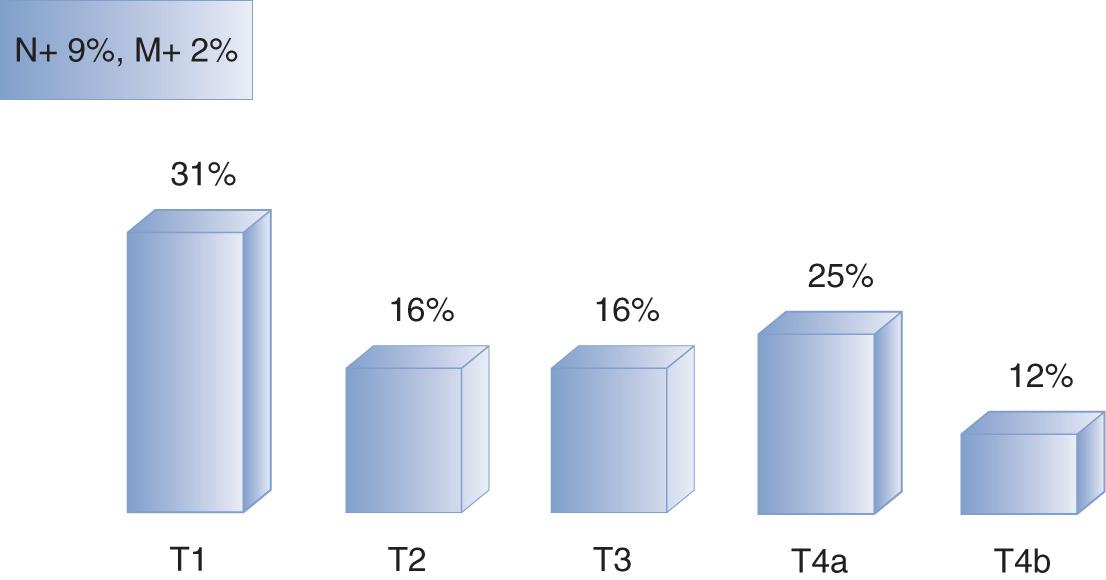
Intranasal lesions, especially those in the inferior aspect of the nasal cavity, can be assessed in the office by anterior rhinoscopy or nasal endoscopy ( Fig. 5.4 ). Nasal endoscopy may be performed with rigid 0-degree and 30-degree endoscopes or a flexible fiberoptic endoscope. Examples of endoscopic views of sinonasal lesions are shown in Figs. 5.5 through 5.10 . A topical spray of 0.5% phenylephrine and 4% lidocaine generally provides good decongestion and topical anesthesia to allow adequate examination of the nasal cavity. Care must be exercised to avoid trauma and manipulation of the tumor to prevent bleeding. It is important to keep in mind that tumors causing sinonasal obstruction can induce inflammatory, polyp-like changes in the mucosa of the nasal cavity. Consequently, endoscopic evaluation alone is not sufficient to define the nature and extent of a sinonasal tumor. Radiographic imaging is essential for all patients suspected of having a neoplasm of the nasal cavity or paranasal sinuses.
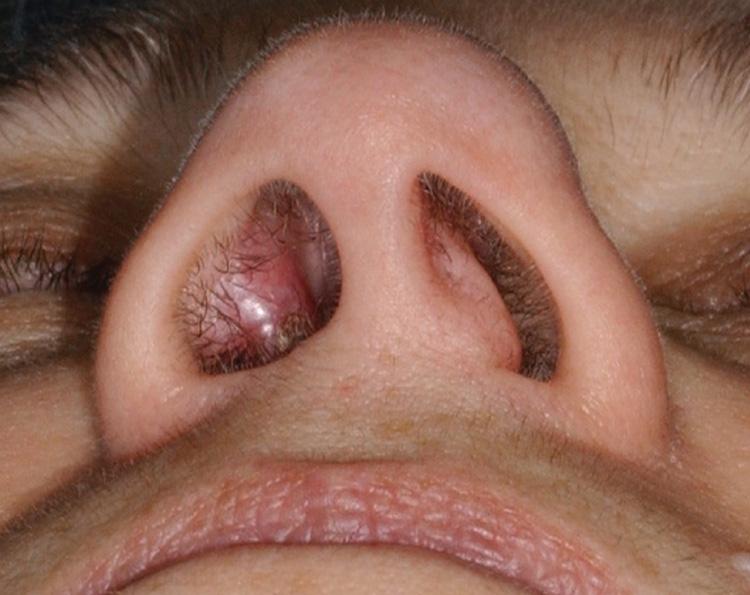

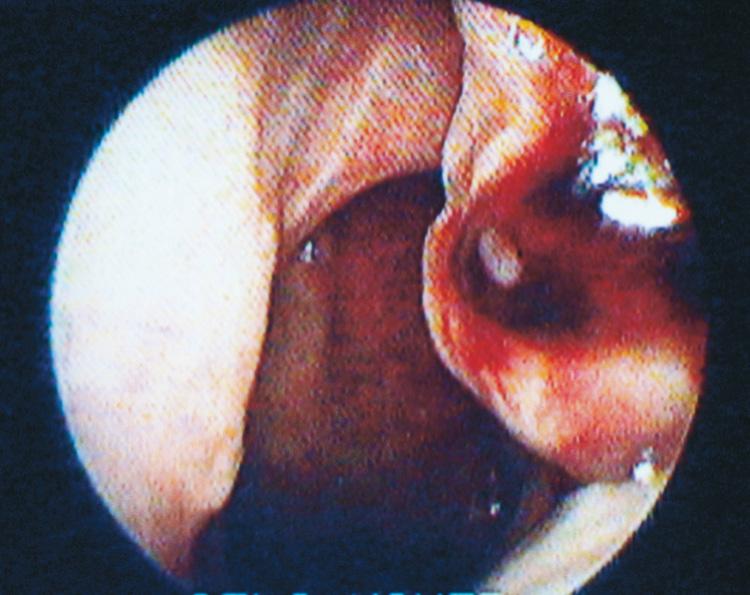
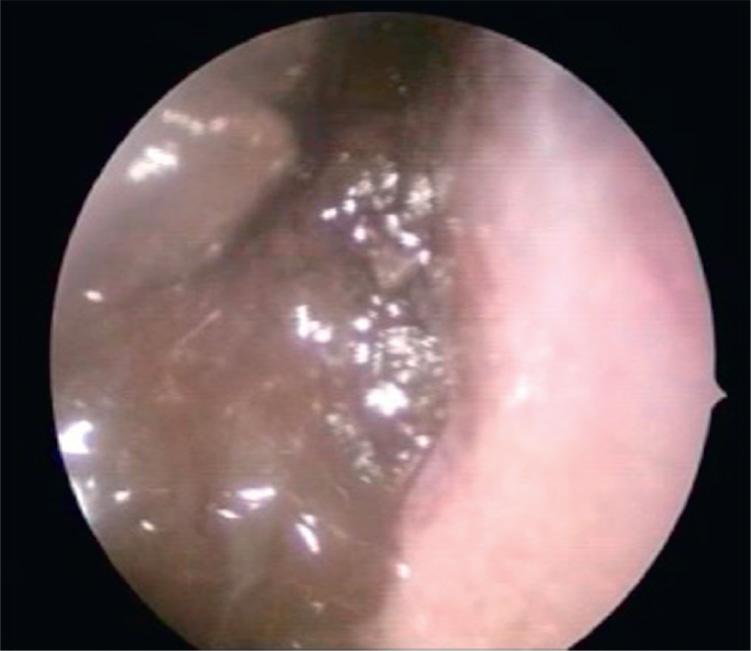
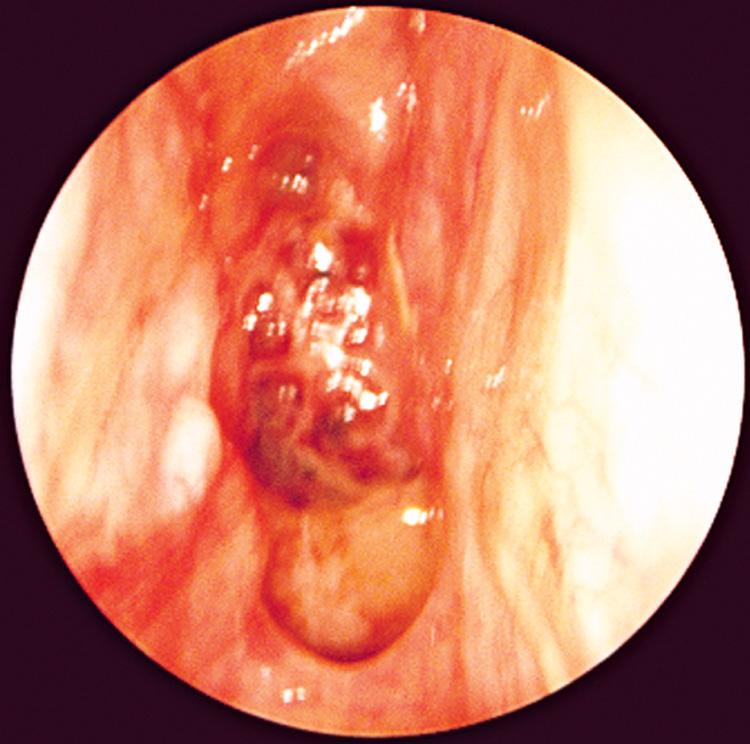
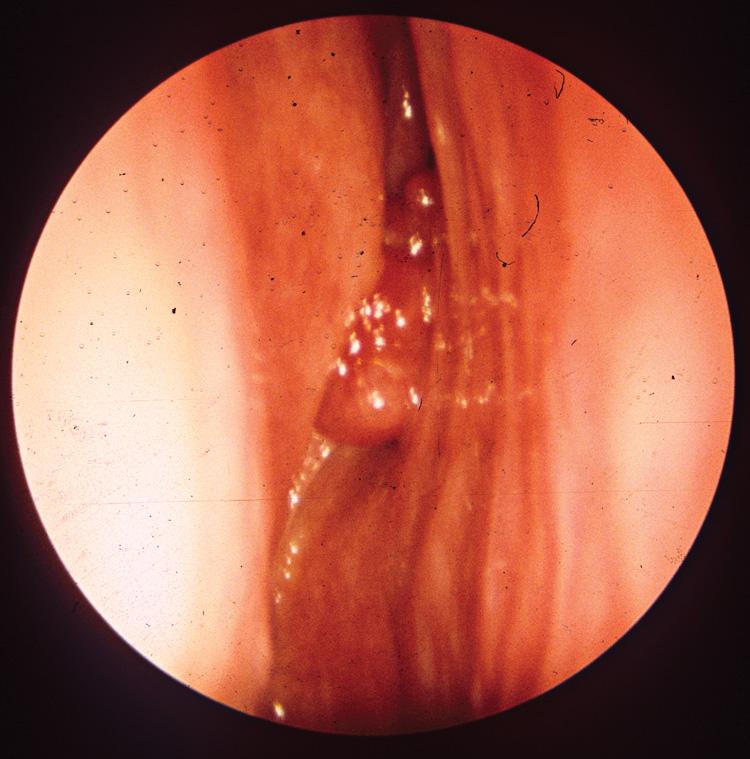
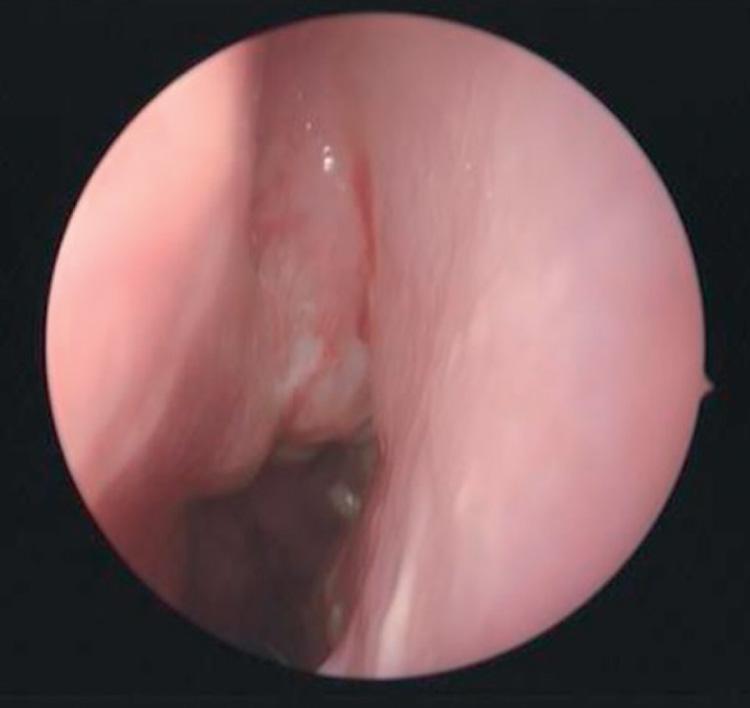
A noncontrast sinus computed tomography (CT) scan is usually the initial examination obtained, because most patients present with nonspecific sinonasal symptoms. Although this study may raise suspicion for a tumor, it is not optimal for accurate assessment of the anatomic extent of the tumor. Further options for radiographic workup include contrast-enhanced CT and magnetic resonance imaging (MRI) of the sinuses. The important features in the assessment of sinonasal tumors are the extent of soft tissue and bone invasion, orbital and intracranial extension, and perineural invasion. CT and MRI have strengths and weaknesses that complement each other in defining the precise extent of the tumor ( Box 5.1 ).
Advantages of computed tomography
Better delineation of bony changes: expansion, remodeling, erosion
Bony or cartilaginous matrix
Calcifications
Advantages of magnetic resonance imaging
Better tumor delineation relative to adjacent tissue
Tumor versus inflammatory change
Orbital and/or intracranial extension
Perineural spread
Modern multidetector CT scanners allow fast acquisition of data that can then be reconstructed in axial, coronal, or sagittal planes. CT is better for evaluating bone changes, including expansion, remodeling, and erosion or destruction. Bone destruction is more commonly associated with aggressive malignant tumors ( Fig. 5.11 ). In general, tumors that cause poorly defined, destructive changes are squamous cell carcinoma, esthesioneuroblastoma, sinonasal undifferentiated carcinoma, adenocarcinoma, lymphoma, and metastatic lesions. On the other hand, regressive remodeling of adjacent bone suggests the diagnosis of benign tumors such as inverted papilloma, schwannoma, pleomorphic adenoma, and juvenile nasopharyngeal angiofibroma but can also include low-grade minor salivary gland carcinomas, melanoma, and lymphoma ( Fig. 5.12 ). The presence of calcification is a feature often associated with esthesioneuroblastomas ( Fig. 5.13 ). Tumors of cartilage and bone origin exhibit cartilaginous or bony matrix ( Fig. 5.14 ). These radiographic features can help in narrowing the differential diagnosis of a tumor. In addition, three-dimensional reconstructions of CT scans can assist in surgical treatment planning for complex lesions that involve the skull base and for planning of reconstructive surgery or a maxillofacial prosthesis ( Fig. 5.15 ).
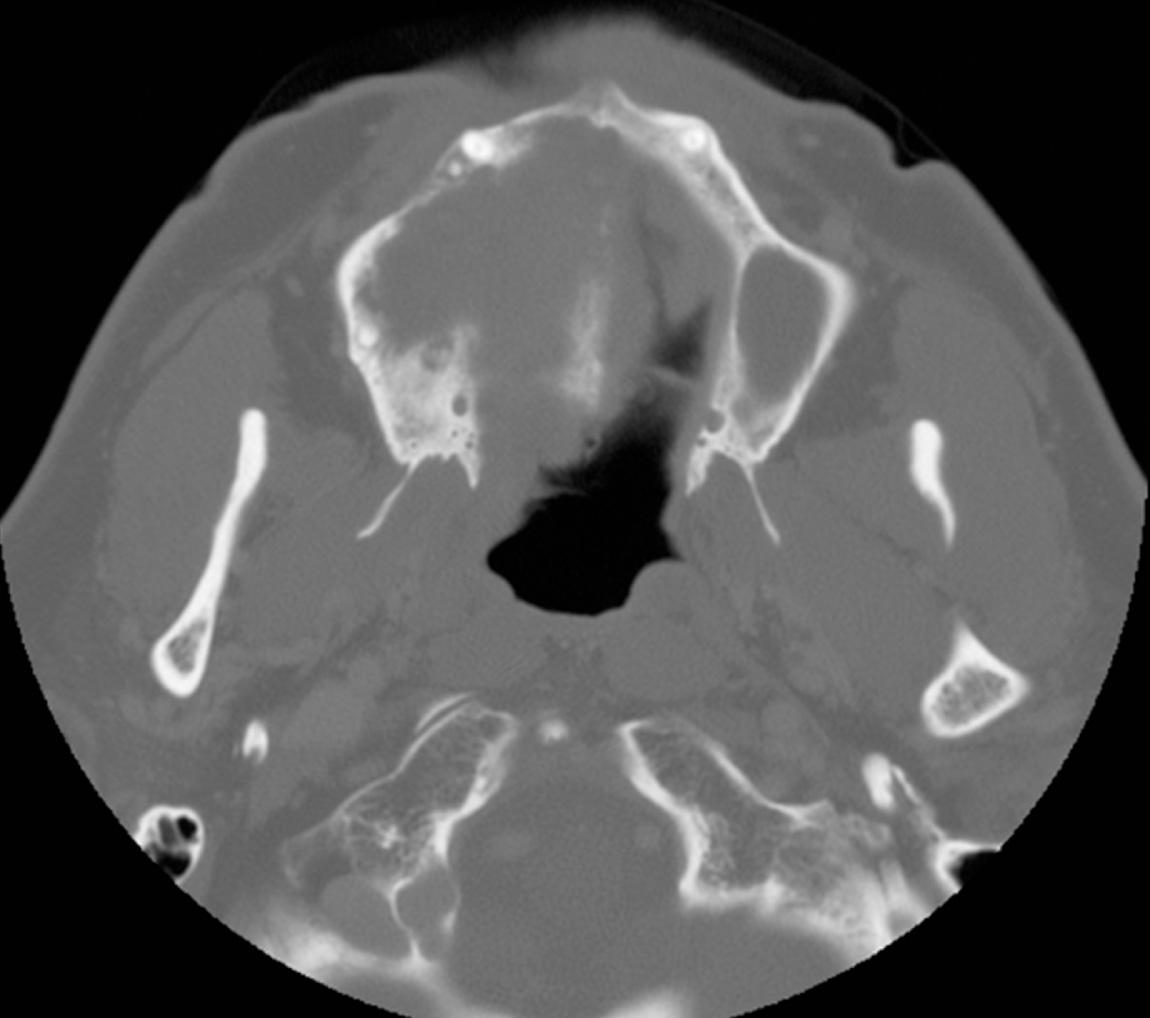
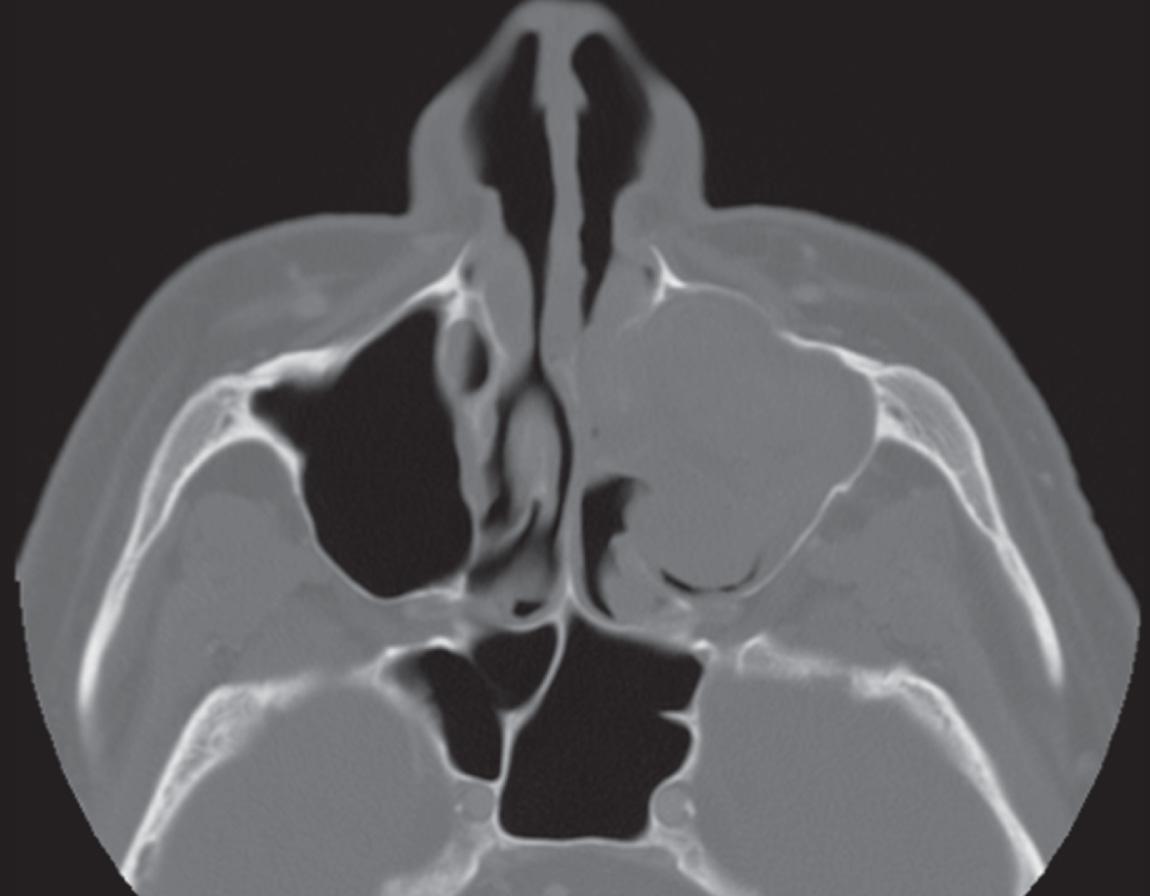
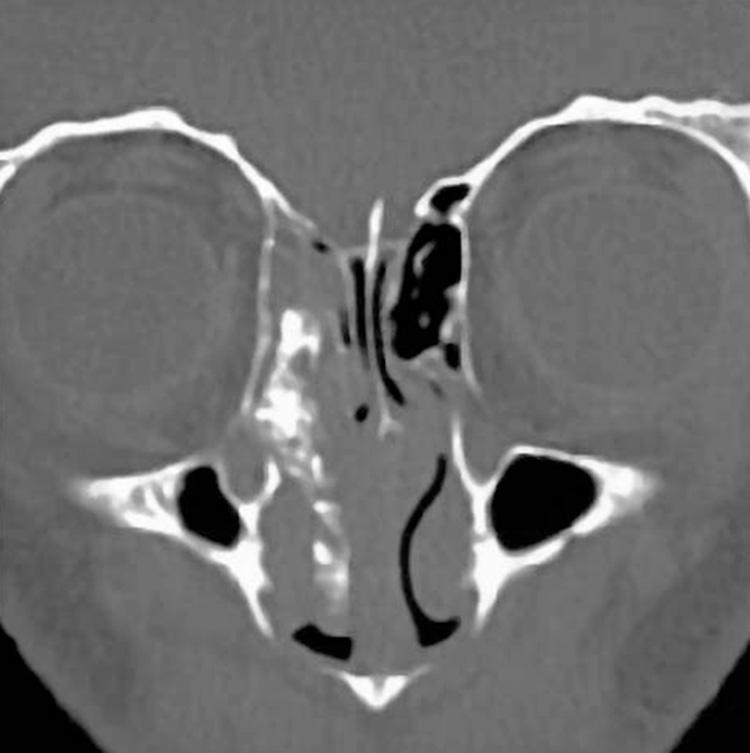
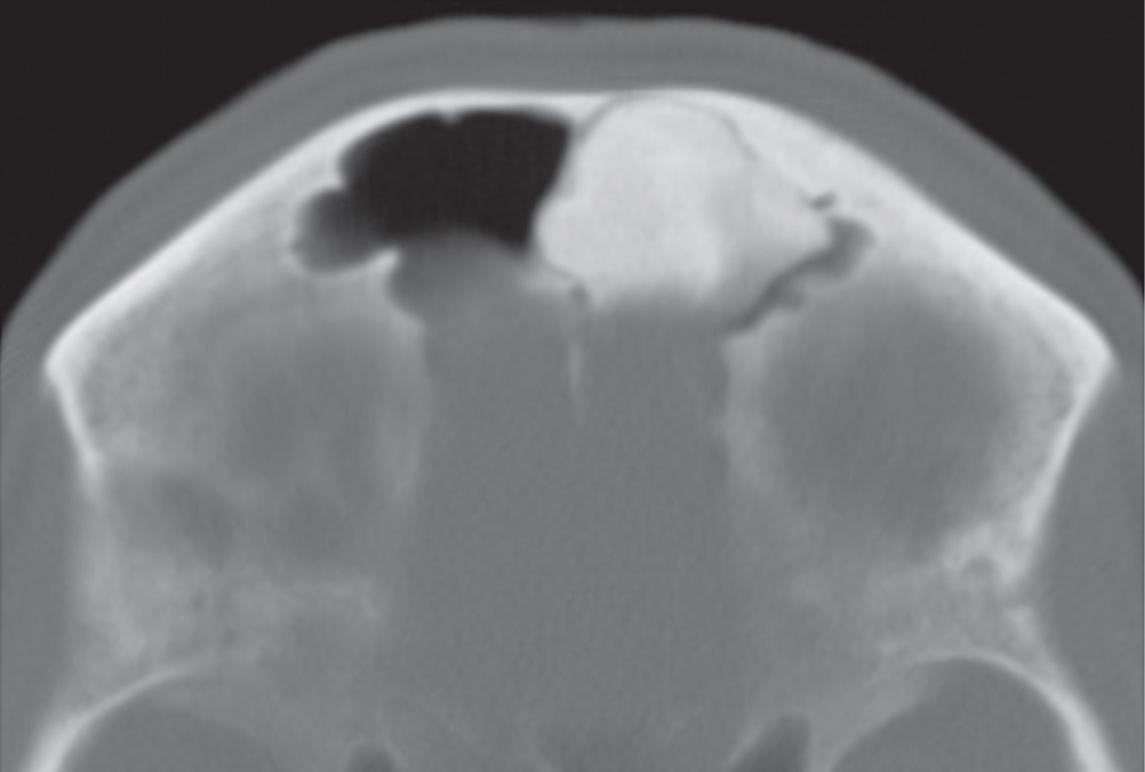
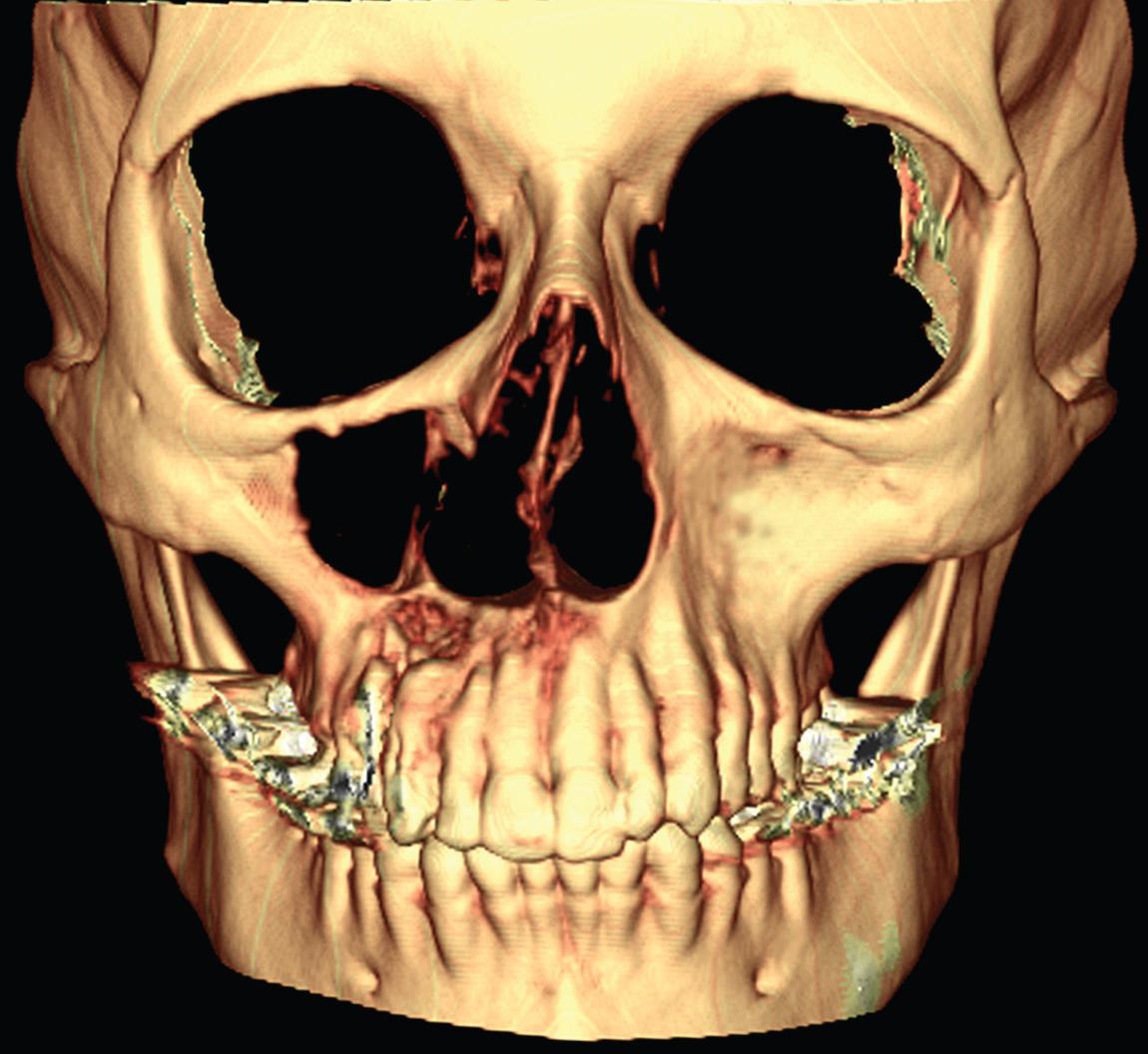
MRI is most advantageous in delineating a tumor relative to adjacent normal soft tissue. Most tumors are low to intermediate signal on T1-weighted MRI and intermediate on T2-weighted MRI; they enhance only moderately because they are highly cellular with little water content. On the other hand, some minor salivary gland tumors, schwannomas, and inverted papillomas have a higher water content and a characteristic bright T2-weighted signal. Most bones around the sinuses, with the exception of the hard palate, do not contain enough marrow for MRI to resolve tumor involvement. A CT scan easily demonstrates bone erosion or destruction. Obstruction of a sinus cavity by a tumor and the extent of postobstructive mucosal changes can be difficult to delineate accurately on noncontrast CT. Contrast-enhanced CT generally can differentiate a tumor from postobstructive inflammatory change. However, MRI clearly delineates a tumor from inflammatory change because of obvious differences in signal intensity between these two entities on all sequences. In particular, postobstructive change is typically very bright on T2-weighted MRI ( Fig. 5.16 ). MRI is superior to CT in demonstrating orbital and intracranial extension ( Fig. 5.17 ). Perineural spread of disease is better defined on MRI ( Fig. 5.18 ). Encroachment or invasion of normal fat in locations such as the orbit, pterygopalatine fossa, pterygomaxillary fissure, or premaxillary region is easily detected on precontrast T1-weighted MRI because fat is bright while most tumors are darker. After the contrast is administered, fat tends to blend with adjacent enhancing tumor, and therefore fat suppression techniques must be used in postcontrast MRI ( Fig. 5.19 ). The different information gained from CT and MRI is exemplified in a patient with a 10-year history of a slowly enlarging low-grade mucoepidermoid carcinoma of minor salivary origin in the hard palate. Axial, coronal, and sagittal views of the noncontrast CT scan shows a bone-destructive lesion of the hard palate and upper alveolus extending into the maxillary sinus with expansion of the maxillary antrum ( Fig. 5.20A through C ). Axial and coronal views of the T2-weighted images show that the content of the maxillary sinus is bright, indicating that it is fluid, secondary to an obstructive inflammatory process ( Fig. 5.20D and E ). A postcontrast T1-weighted image in the coronal plane shows that the lesion is confined to the hard palate and upper alveolus with clear demarcation of tissue planes from the maxillary antrum ( Fig. 5.20F ). The expanded maxillary sinus is filled with soft tissue and shows no contrast enhancement. On the axial and sagittal views, some air is seen in the anterior aspect of the antrum. Thus both CT and MRI in this case helped in arriving at an accurate diagnosis and facilitated treatment planning.
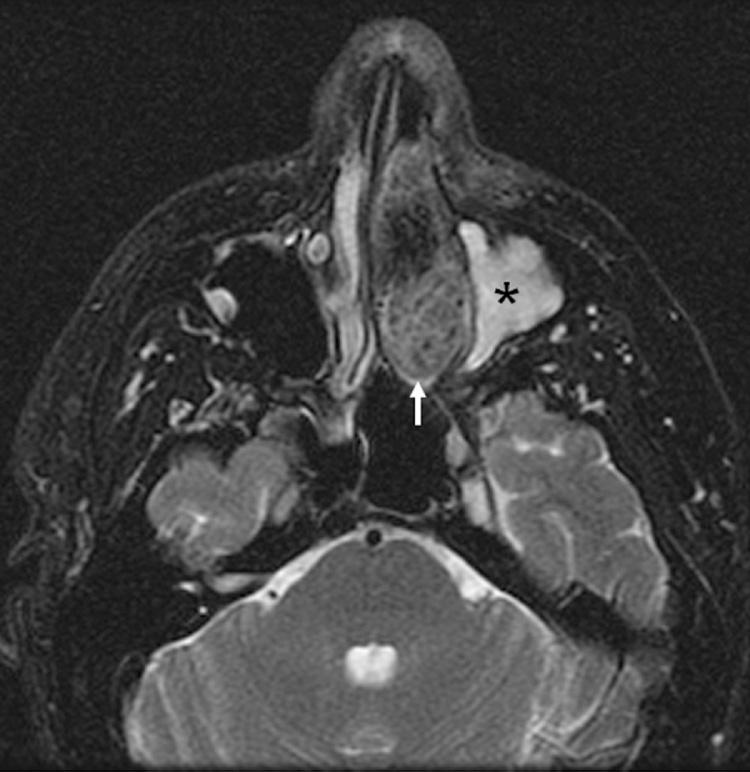
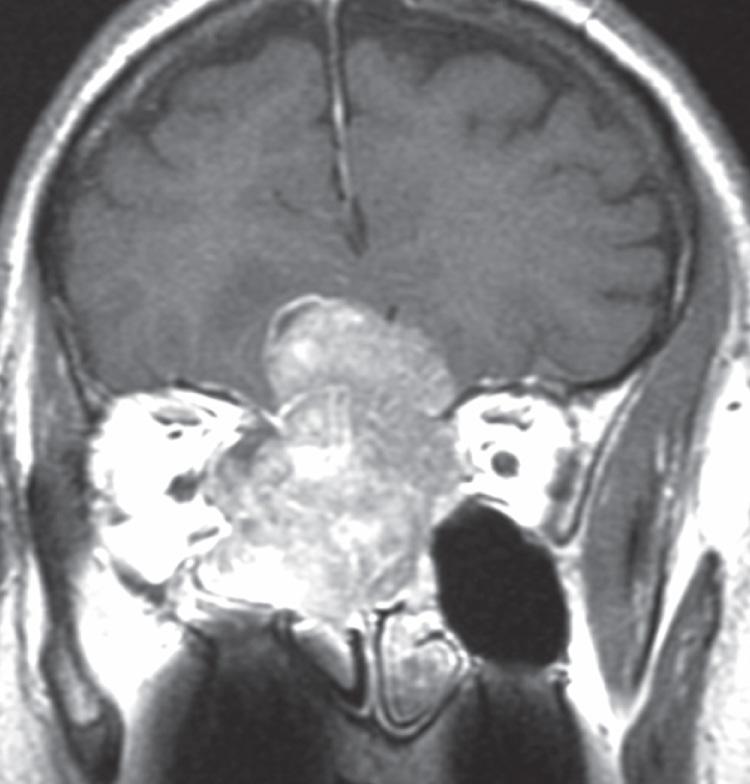
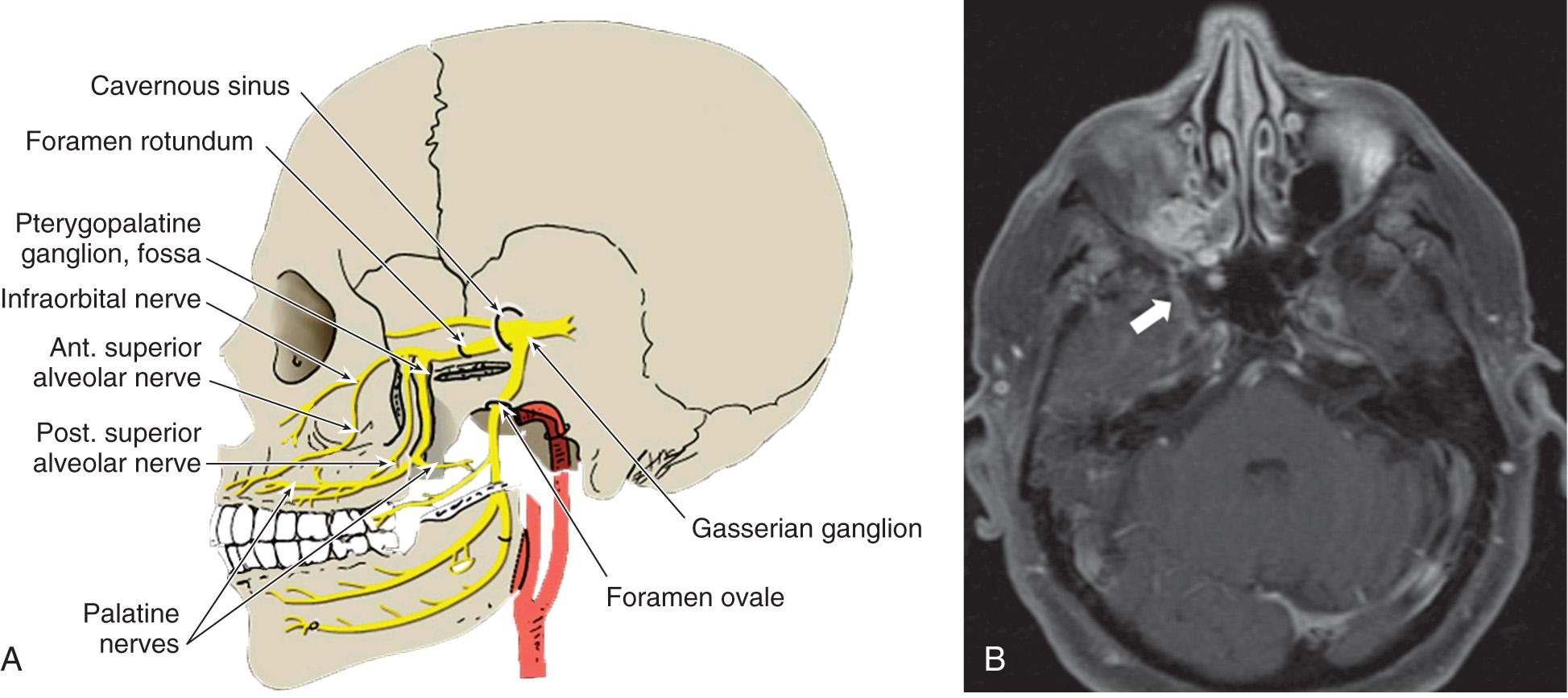
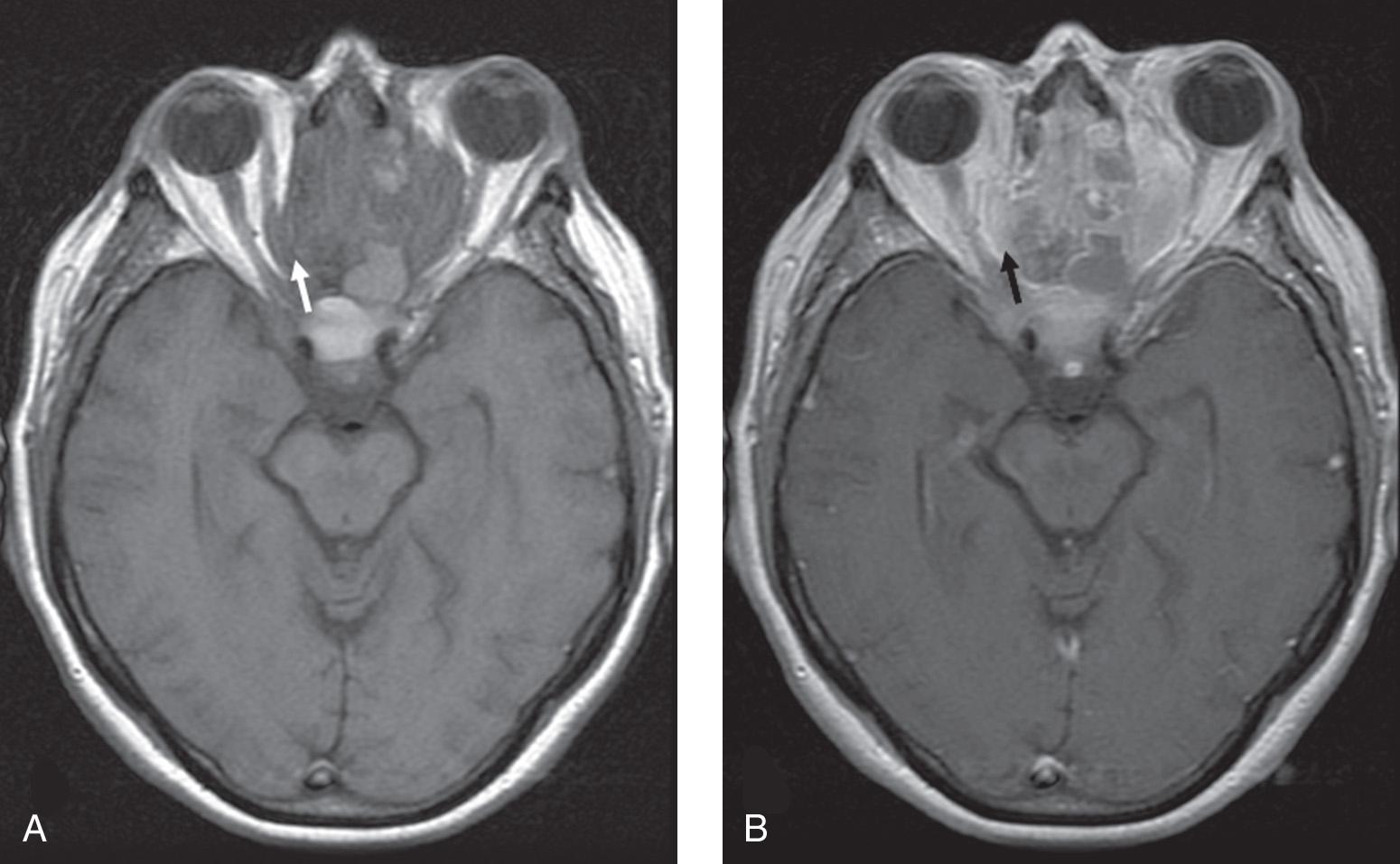

In contrast to CT and MRI, 18F-fluorodeoxyglucose–positron emission tomography (FDG-PET) scan generally does not play an important role in the initial local assessment of sinonasal tumors. However, PET/CT is useful for assessment of regional and distant disease ( Fig. 5.21 ). In addition, it is particularly useful in posttreatment surveillance to diagnose viable tumors, as shown in Fig. 5.22 . Further, PET scan can also draw attention to FDG-avid lesions, which when confirmed by contrast-enhanced CT scans would be considered for biopsy. The patient whose posttreatment surveillance PET scan is shown here had previously undergone treatment of nasopharyngeal carcinoma. The PET scan showed an FDG-avid hotspot on the left lateral wall of the nasopharynx ( Fig. 5.23A ). Contrast-enhanced CT scan in axial and coronal views showed a rim-enhancing lesion ( Fig. 5.23B and C ). These findings facilitated a precise biopsy of the lesion under CT-guided navigation ( Fig. 5.23D ). The biopsy in this patient showed an abscess from radiation necrosis.

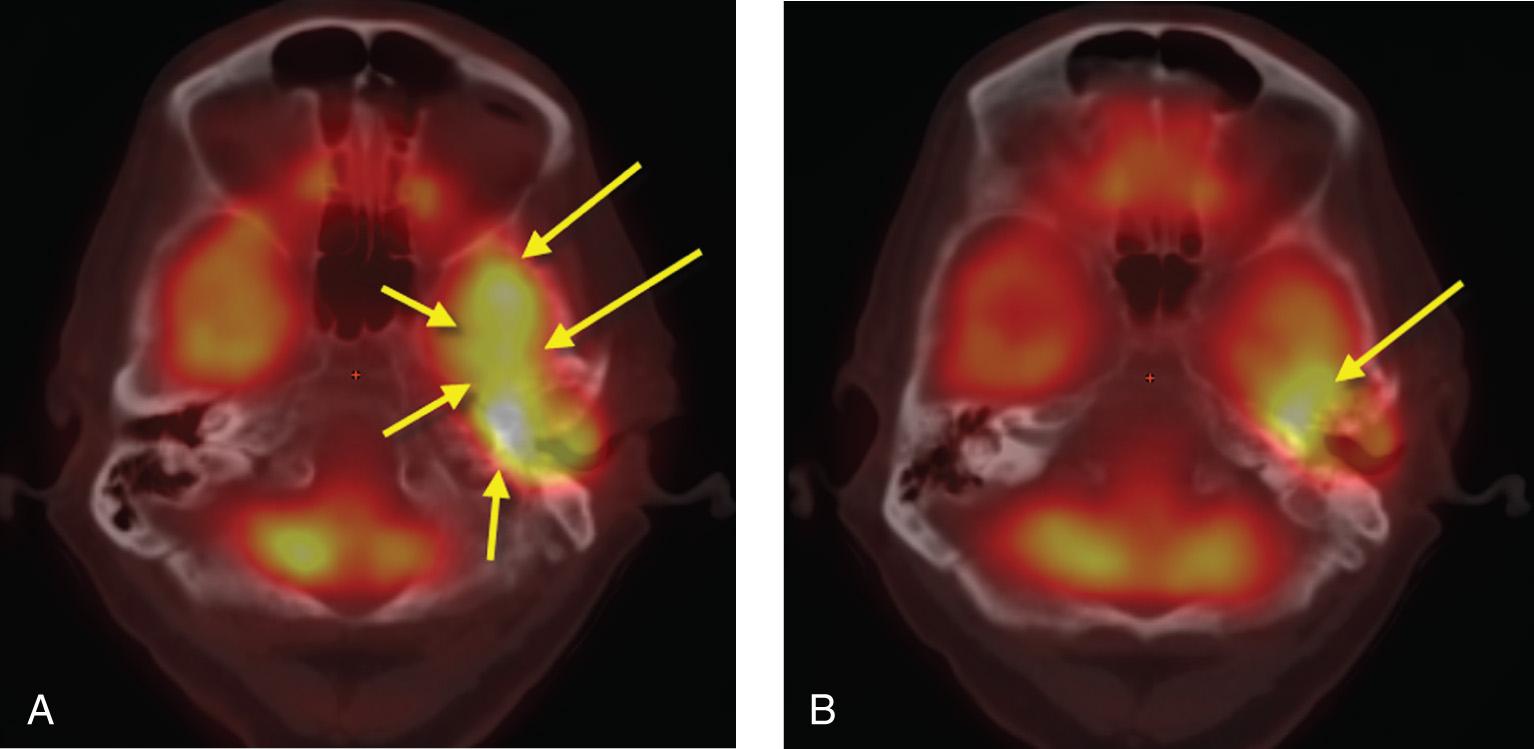
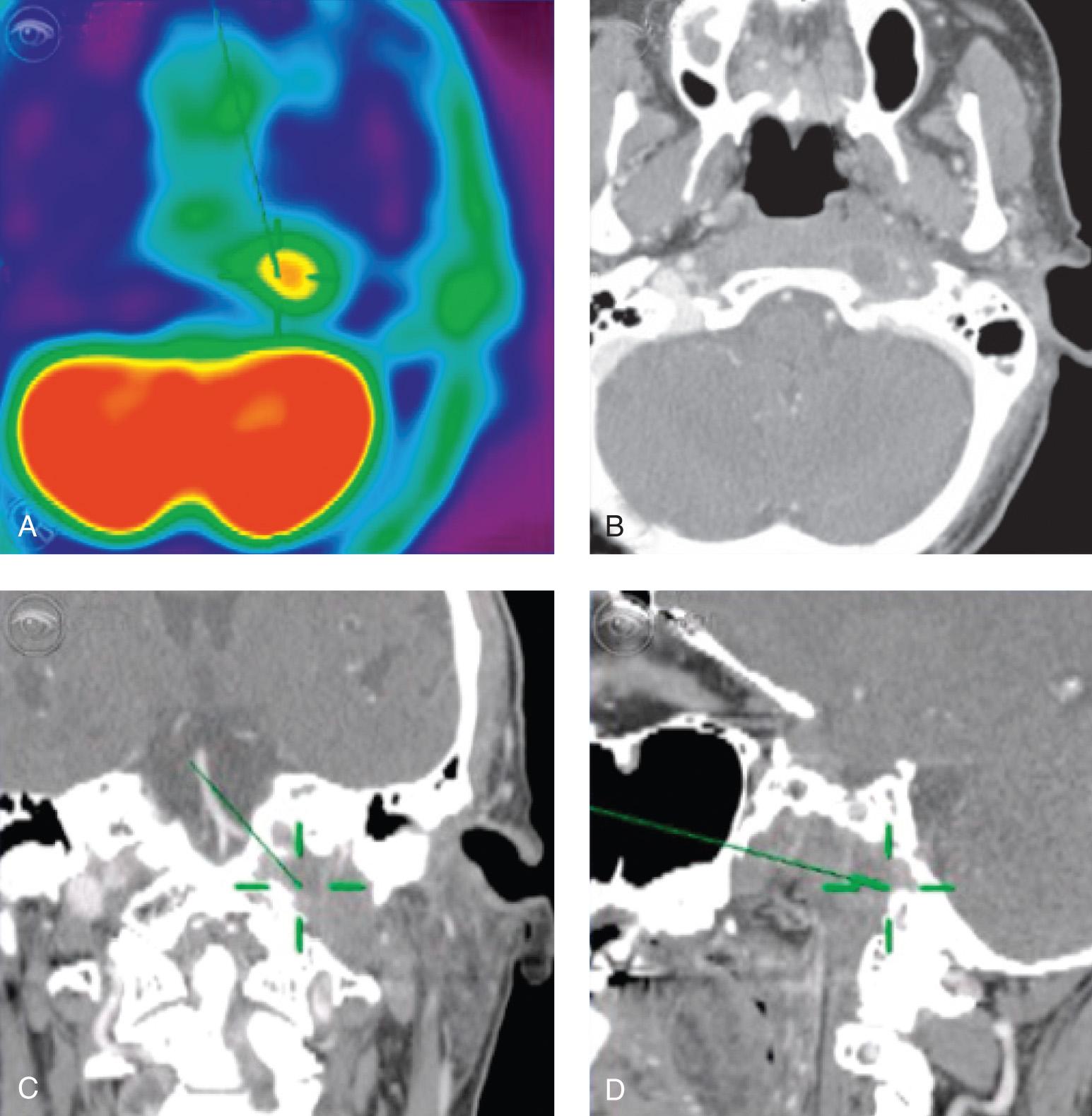
Tissue diagnosis of a lesion of the nasal cavity or paranasal sinuses is required before undertaking definitive treatment, except in selected circumstances in which radiologic characteristics may be sufficient to establish the diagnosis (e.g., angiofibroma). The approach to the biopsy of a sinonasal tumor is dictated by the anatomic location and radiologic characteristics. For lesions that are visible through the nasal cavity or oral cavity, a simple punch biopsy may be sufficient to establish tissue diagnosis. Transnasal biopsies should be performed in an environment with appropriate instrumentation and support, in case of unexpected bleeding. The approach to the biopsy of tumors that are not readily accessible for transnasal or transoral biopsy, such as those in the maxillary antrum, the posterior and/or superior aspect of the nasal cavity, the frontal sinus, or the infratemporal fossa, should not entail approaches that violate subsequent surgical planes. For example, a Caldwell-Luc antrotomy should be avoided, because it would contaminate the soft tissues of the cheek if it was used to obtain a biopsy specimen of a malignant tumor of the maxillary antrum, making a curative resection more complicated. In experienced hands, most nasal cavity lesions can be biopsied in the office with a straight or angled endoscope and Blakesley forceps after topical anesthesia is applied. Hemostasis is attained through direct pressure and vasoconstrictor sprays. In cases in which the patient is unable to tolerate this biopsy under local anesthesia, the clinic has inadequate equipment, or there are concerns about a fragile tumor, transnasal endoscopy with biopsy under sedation or general anesthesia should be considered. Before embarking on in-office biopsy, it is critical to ensure that the sinonasal lesion is not an encephalocele or a primary vascular tumor. In addition, surgical biopsy under general anesthesia has the benefit of the ability to use navigation systems that provide image guidance with CT, MRI, or PET-fused images, in order to allow precise localization of tumors that are in close proximity to vital structures (see Fig. 5.23 ). This renders biopsy safe and accurate. This would not be possible without help from intraoperative navigation. Finally, for tissue diagnosis for otherwise inaccessible sinonasal tumors or tumors of the infratemporal fossa, a CT-guided needle biopsy should be considered.
A wide variety of benign neoplasms arise in the sinonasal tract. The most common benign neoplasm, the sinonasal papilloma, originates from well-differentiated ciliated columnar or respiratory epithelium with varying degrees of squamous differentiation. Papillomas can be categorized into three broad categories—exophytic, oncocytic, and inverted—or they can be categorized collectively as Schneiderian papillomas. Exophytic papillomas predominantly arise from the nasal septum ( Fig. 5.24 ). On the other hand, columnar cell and inverted papillomas most commonly arise from the lateral nasal wall of the nasal cavity or in the maxillary sinus ( Fig. 5.25 ). Exophytic and oncocytic papillomas are easily treated with conservative, endoscopic surgical excision. Conversely, inverted papillomas have an endophytic, infiltrative growth pattern that can cause destruction of adjacent tissue and may not be suitable for endoscopic excision, because they have a high tendency for recurrence after conservative surgical excision. Moreover, about 10% of inverted papillomas undergo malignant transformation into squamous cell carcinoma. Malignant degeneration is usually detected at the time of initial presentation, but it can also occur metachronously in up to one-third of cases.
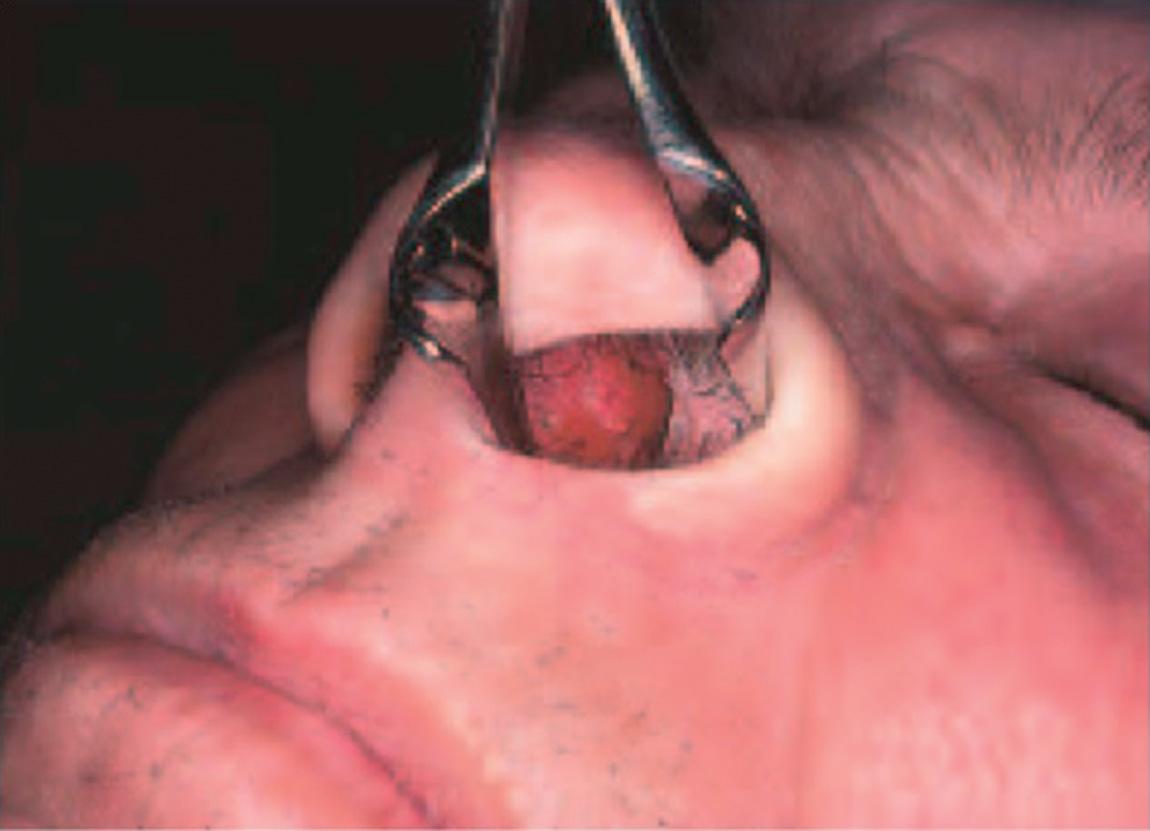
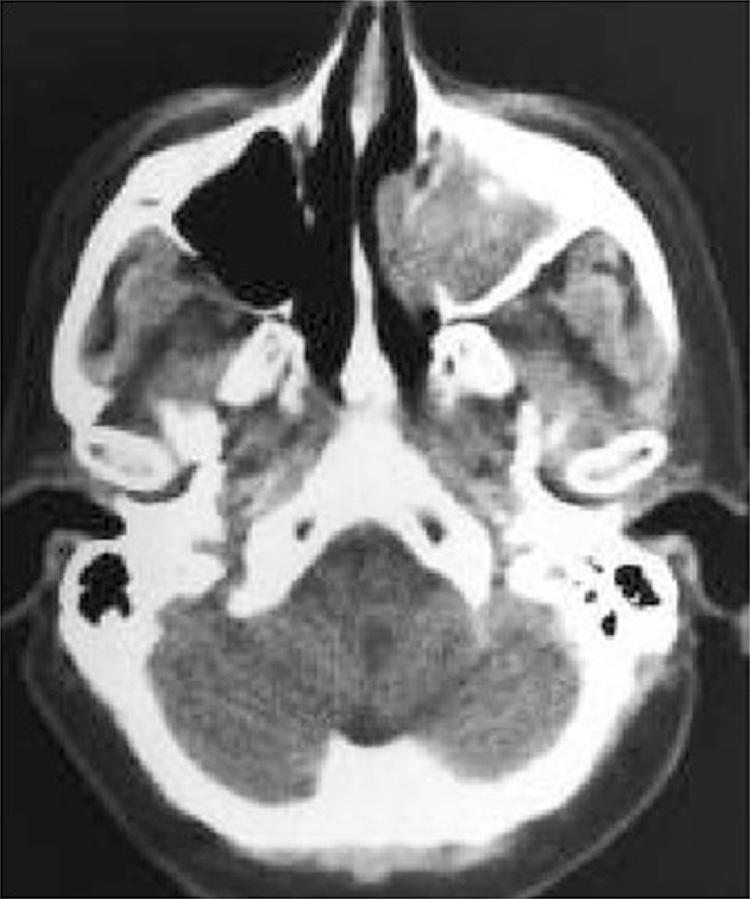
The relationship between inverted papillomas and HPV is controversial, with studies showing variable expression of HPV in these tumors. Recent studies suggest a higher prevalence of HPV in inverted papillomas but with low transcriptional activity. Most inverted papillomas lack nuclear features associated with viral integration, namely, nuclear inclusions. Histologically they are composed of hyperplastic epithelium, both the ciliated respiratory type and squamous. Up to 20% of inverted papillomas may show surface keratinization, and anywhere from 5% to 10% may show varying degrees of dysplasia. These two latter features, although not necessarily indicative of malignancy, should reinforce the need for thorough histologic evaluation of the lesion ( Fig. 5.26 ). Recurrence does not correlate with the subsequent development of malignancy. When malignancy does occur, it most frequently manifests in the form of squamous cell carcinoma; however, verrucous carcinoma, mucoepidermoid carcinoma, spindle cell carcinoma, and clear cell carcinoma also may be seen. Wide surgical resection is the mainstay of treatment for inverted papillomas and can be performed endoscopically or by an open approach based on the extent and location of the tumor. Long-term follow-up is recommended, given the possibility for late failure.
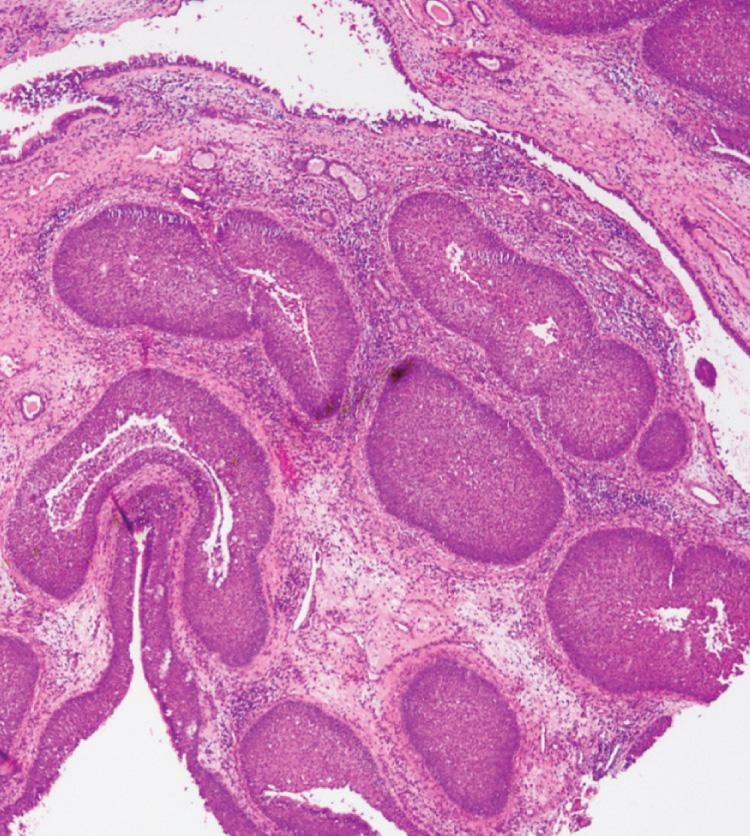
Juvenile nasopharyngeal angiofibromas (JNAs) are tumors that most commonly arise in adolescent boys. A JNA typically arises submucosally in the posterolateral nasal wall, posterior to the sphenopalatine foramen. Although the cell of origin for this neoplasm is still under debate (i.e., whether these tumors are derived from stromal cells or are vascular in origin), data suggest that this complex pathogenesis involves androgenic hormones, angiogenic factors, and the adenomatous polyposis coli/β-catenin pathway. Epidemiologic observations showing spontaneous regression after puberty, combined with empirical and laboratory evidence of responsiveness to estrogen therapy, suggest that JNA may be hormonally regulated. In an age-matched population, JNAs are 25 times more common in patients with familial adenomatous polyposis. These tumors show a propensity toward expansion into adjacent structures, causing local mass effects. Diagnosis usually is made on the basis of patients’ age and gender, clinical history of frank epistaxis, nasal endoscopic examination, and imaging studies. Grossly, JNAs are smooth, lobulated or multinodular pink-white masses that may show surface ulceration and distinct vascularization. The corresponding histology demonstrates a collagenous stroma with stellate cells and prominent thin-walled vascular channels that may be “staghorn” in appearance, similar to those seen in hemangiopericytomas ( Fig. 5.27 ). These tumors are highly vascular, and thus biopsy is not recommended because of the risk of significant hemorrhage. The characteristic radiologic features of JNA include signal voids and strong postcontrast enhancement on MRI and CT scans. Surgical treatment is typically recommended with either an endoscopic or an open surgical approach to access the lesion. Preoperative embolization has been shown to decrease intraoperative bleeding. It clearly reduces vascularity of the tumor and minimizes intraoperative bleeding ( Fig. 5.28 ). Radiation therapy has been shown to restrict growth and augment control as an adjuvant to surgery in selected cases. However, it is considered only in situations of massive unresectable tumors, or recurrent tumors in difficult locations, since there is the risk of long-term sequelae of radiation therapy in the young patient.
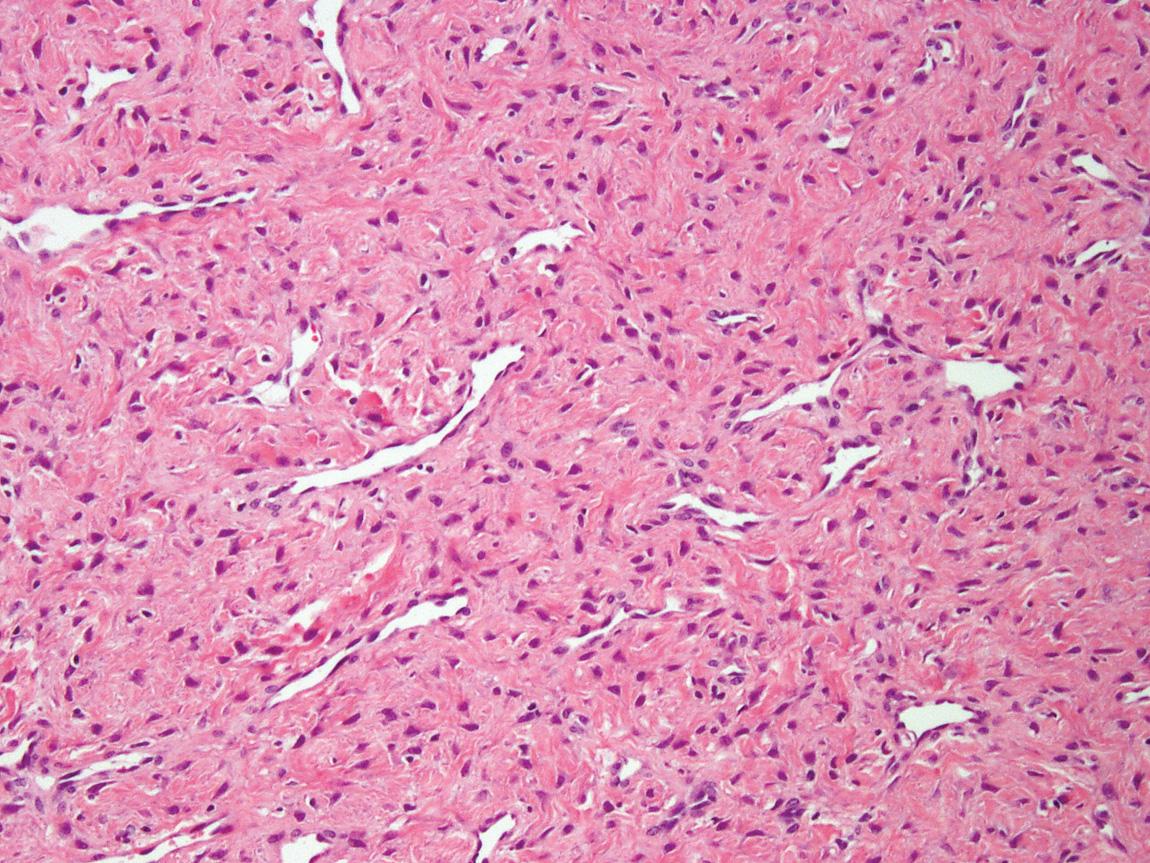
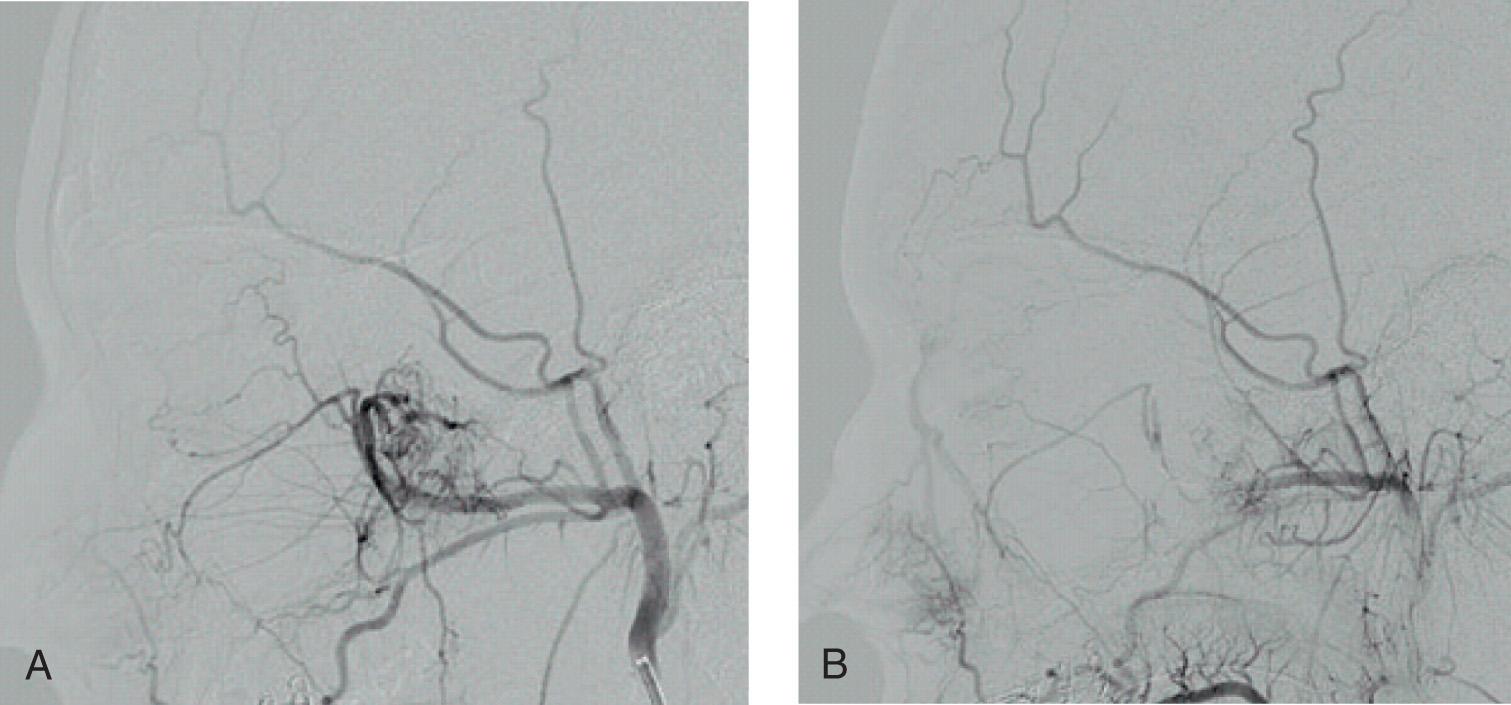
Other benign tumors of the sinonasal tract include those of epithelial origin (adenomas), mesenchymal origin (hemangiomas, fibromyxomas, and chondromas), and bony origin (osteomas, fibrous dysplasias, and ossifying fibromas). Most of these tumors can be diagnosed accurately on the basis of clinical and radiologic features, with biopsy required only in select situations.
Osteomas are bony lesions covered by mucosa that most commonly arise in the frontoethmoidal region. In general, they show slow and steady growth. Treatment is required only for symptomatic lesions or for a rapidly growing tumor that causes compression of vital structures or facial deformity. Patients with multiple osteomas should be carefully screened for Gardner's syndrome, an autosomal-dominant condition associated with a triad of colonic polyps that degenerate into malignancy, supernumerary teeth, other fibroosseous tumors and skeletal abnormalities.
Fibrous dysplasia primarily occurs in children and typically regresses at puberty. Although fibrous dysplasia can be deforming, it usually is not destructive. Radiologically these lesions are characterized by their “ground glass” appearance. The vast majority of these tumors are monostotic (>75%) but may involve the entire facial skeleton. The polyostotic form is associated with McCune-Albright syndrome, which also includes precocious puberty and café-au-lait spots. In general, because of the high propensity for spontaneous regression, surgical intervention is recommended only for symptomatic cases. Spontaneous regression is characterized by conversion of the classic ground glass radiographic appearance with hazy borders to a cotton wool–like appearance. Malignant degeneration is rare but can occur in the monostotic form. On the other hand, ossifying fibromas present as well-circumscribed lesions having a thin, eggshell-like bony wall and hypodense center. In contrast to other benign bone tumors, ossifying fibromas can be locally destructive, and therefore complete surgical excision is recommended.
Malignant tumors of the sinonasal region most commonly arise from the maxillary antrum, the lateral wall of the nasal cavity, the septum, and ethmoid air cells. Although primary tumors rarely arise from the sphenoid and frontal sinuses, their involvement, as well as that of the skull base, is not uncommon by contiguous disease extension from other paranasal sinuses. Symptoms such as obstruction, epistaxis, epiphora, headache, and diplopia develop late in the course of the disease, and therefore many patients present with an advanced stage at diagnosis. However, presenting symptoms depend on the anatomic site of the tumor.
Öhngren described an imaginary plane defined by a line joining the medial canthus of the eye to the angle of the mandible. This plane divides the region of the nasal cavity and maxillary antrum into two halves ( Fig. 5.29 ). The anatomic region located anterior and inferior to this plane is called the infrastructure, and the region located posterosuperior to this plane is called the suprastructure. In patients with lesions arising from the infrastructure, symptoms generally develop early during the course of the disease, and tumors are readily amenable to a satisfactory surgical resection with an excellent chance for local control. On the other hand, in patients with lesions involving the suprastructure, symptoms develop late in the course of the disease. These tumors generally present with advanced disease and are technically difficult to resect because they often extend to the infratemporal fossa, pterygomaxillary fossa, orbit, skull base at the middle cranial fossa, and/or anterior cranial fossa. The potential for cure of these lesions is clearly less likely compared with tumors arising in the infrastructure.
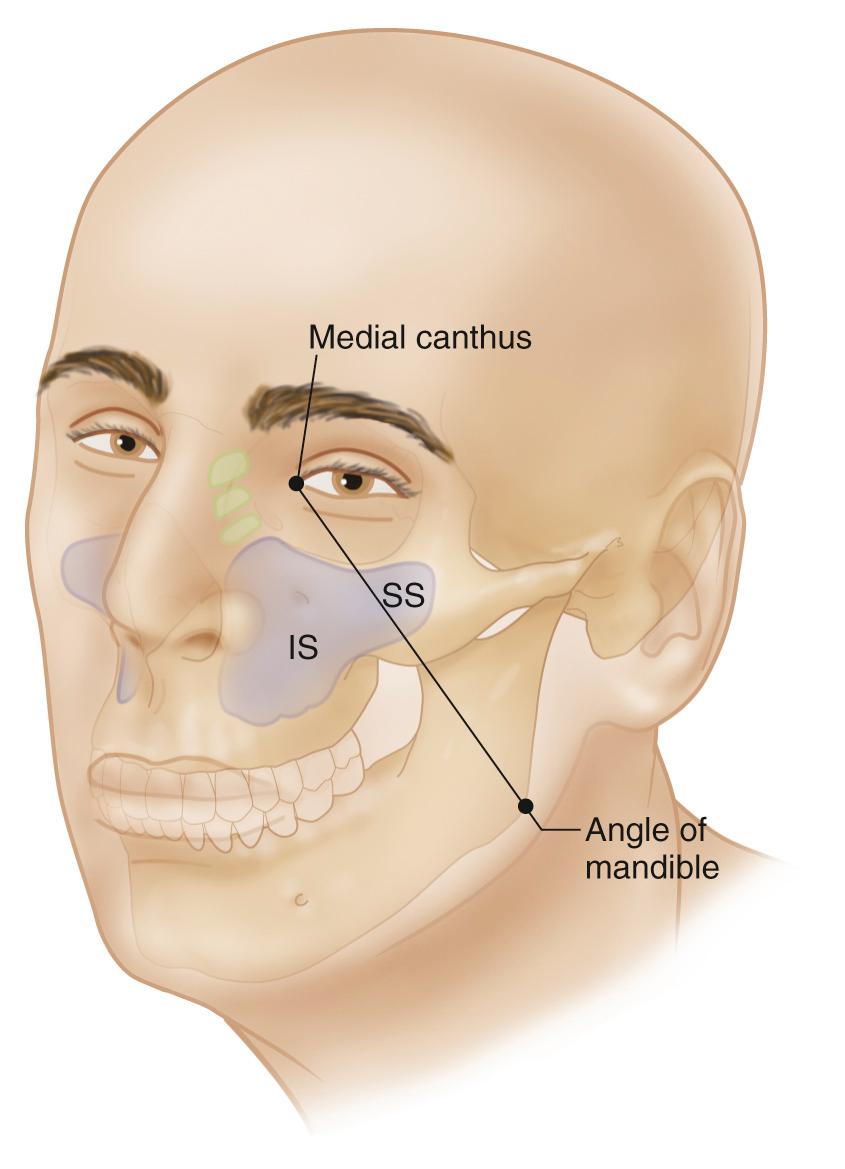
Tumors of the infrastructure of the maxillary antrum may extend through the floor of the antrum into the oral cavity, through its medial wall into the nasal cavity, through its anterior wall to the soft tissues of the cheek, or through its lateral wall into the masticator space ( Fig. 5.30 ). On the other hand, tumors of the suprastructure spread by local extension through the posterior wall of the antrum into the pterygomaxillary space, infratemporal fossa, and the middle cranial fossa; through the roof of the antrum into the orbit; or via the ethmoid air cells to the anterior cranial fossa. Primary malignant tumors of the nasal cavity may invade the hard palate, maxillary antrum, ethmoid air cells, or orbit by local extension ( Fig. 5.31 ). Ethmoid tumors can extend to the sphenoid sinus, anterior cranial fossa, frontal sinus, orbits, nasal cavity, or nasopharynx or into the maxillary antrum ( Fig. 5.32 ). Primary tumors of the frontal and sphenoid sinuses are uncommon and are generally less amenable for curative resection because of more frequent local spread into the cranial cavity with invasion of the dura and brain, cavernous sinus, or clivus ( Fig. 5.33 ). Overall, dissemination to regional lymph nodes is relatively infrequent, occurring in less than 10% of all patients with malignant tumors of the paranasal sinuses.
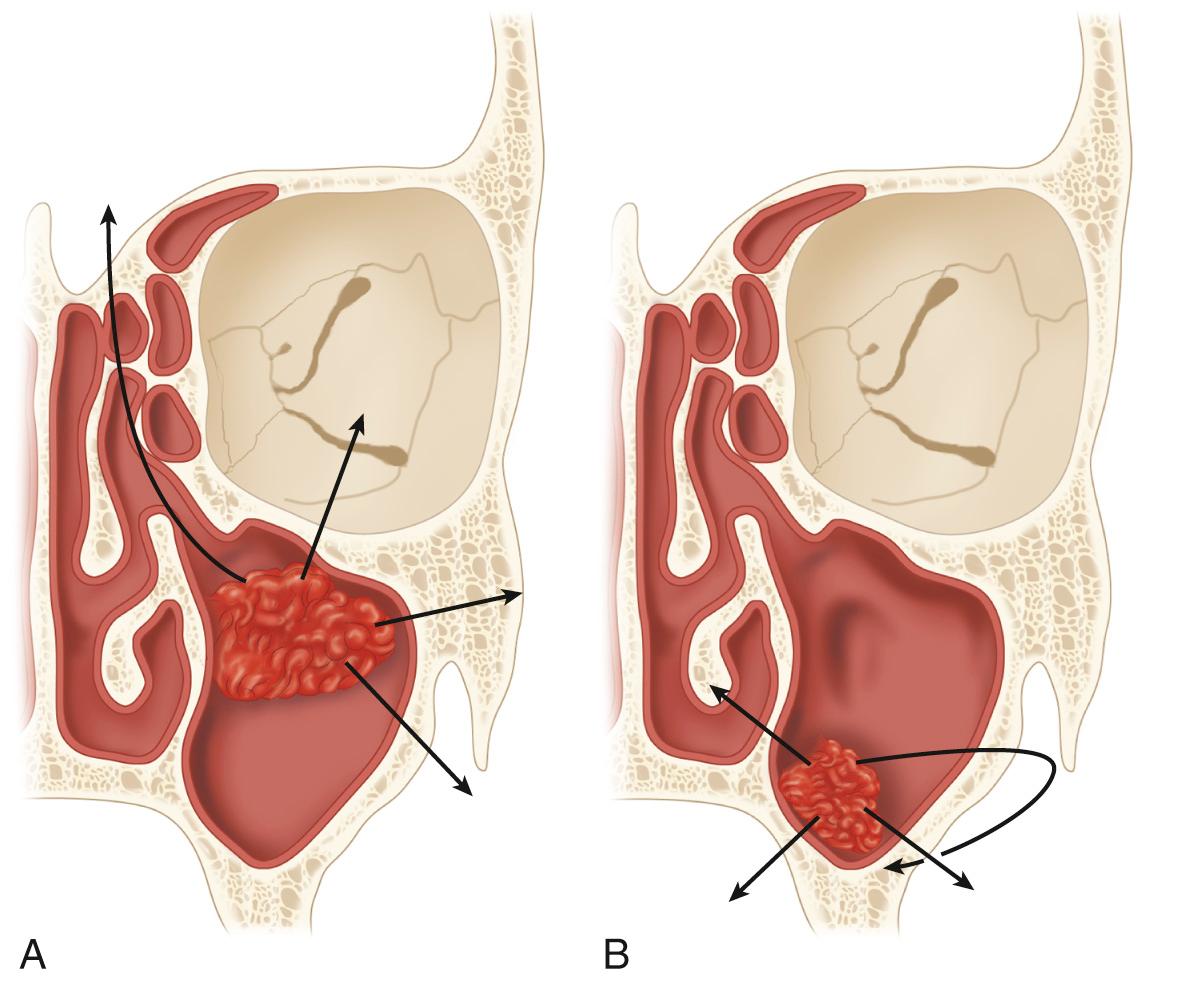
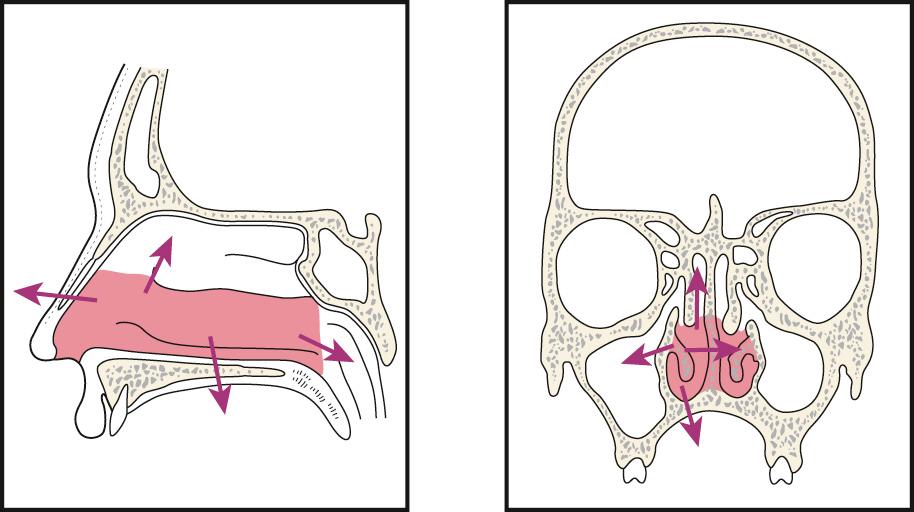
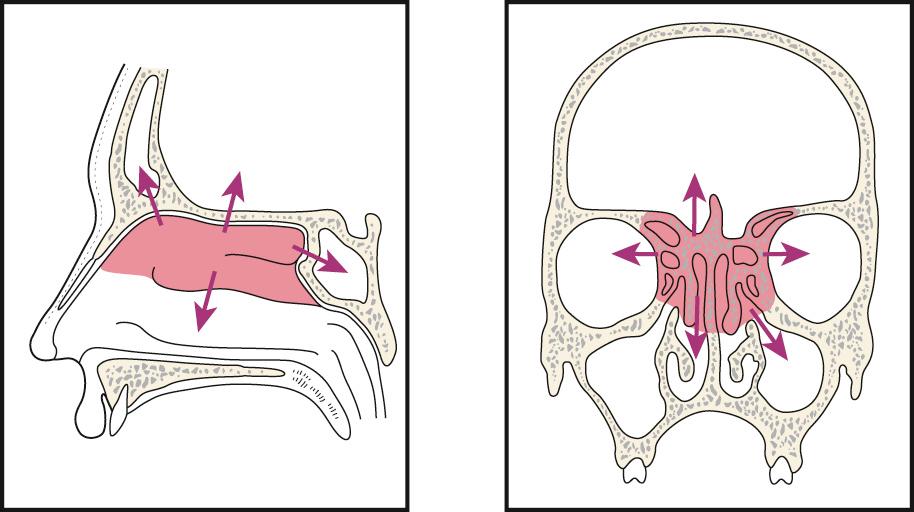
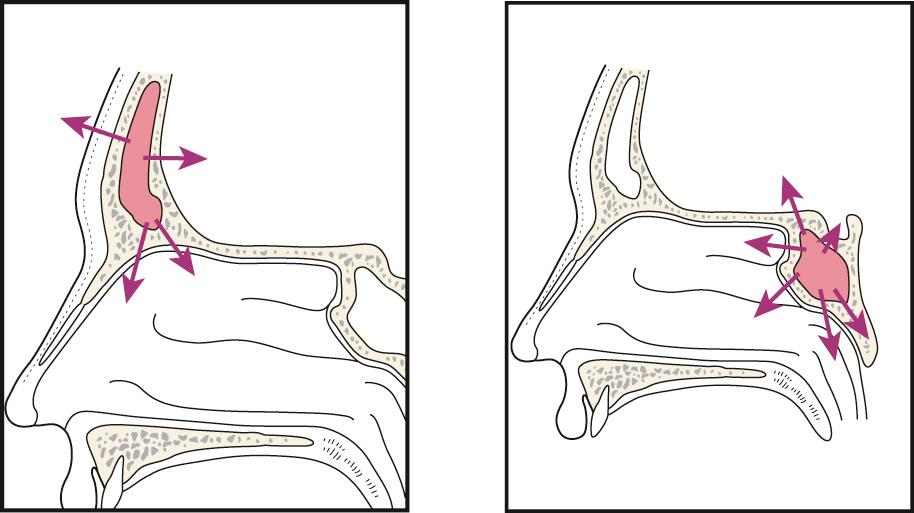
Squamous cell carcinoma is the most common malignant neoplasm of the sinonasal region, accounting for more than 80% of cases. The development of these tumors is associated with tobacco use and occupational exposure to compounds that contain nickel.
Nonsquamous malignant tumors of the sinonasal region include, in order of frequency, carcinomas of minor salivary gland origin, sarcomas, esthesioneuroblastomas, lymphomas, sinonasal undifferentiated carcinomas (SNUCs), and melanomas. The most frequent minor salivary gland malignancy of the sinonasal region is adenoid cystic carcinoma, followed by adenocarcinoma, mucoepidermoid carcinoma, clear cell carcinoma, acinic cell carcinoma, and other rare histologies. Adenoid cystic carcinoma characteristically shows slow progression, with high propensity for perineural invasion and pulmonary metastasis. Exposure to wood dust and chemicals used in the leather manufacturing industry is known to increase the risk for development of sinonasal adenocarcinomas.
Esthesioneuroblastoma, also commonly called olfactory neuroblastoma (ONB), is a malignant neoplasm derived from olfactory epithelium. In 2005 the World Health Organization adopted Hyams’ four-tiered grading system, which is based on lobular architecture, mitosis, necrosis, nuclear pleomorphism, fibrillary matrix, and rosettes. Grades I and II may be placed together as low grade ( Fig. 5.34 ), and grades III and IV are considered high grade. Immunohistochemistry is useful in the evaluation of ONB, with strong synaptophysin and neuron-specific enolase labeling and an absence of cytokeratin and epithelial membrane antigen immunoreactivity. Additionally, S-100 protein immunoreactivity is frequently seen surrounding the nests or lobules, labeling sustentacular cells; however, this feature may be lost in higher grade tumors.
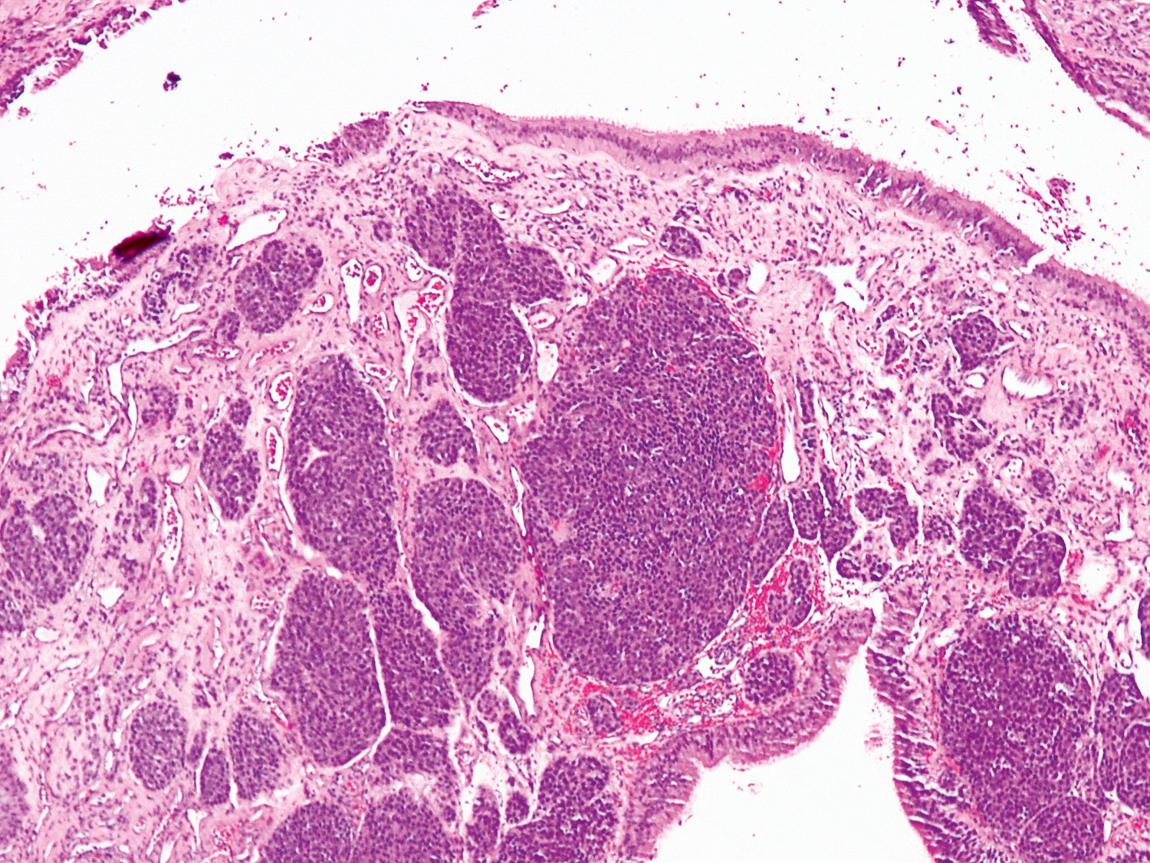
In addition to salivary gland–type adenocarcinomas and metastatic adenocarcinomas, sinonasal adenocarcinomas can be split into intestinal type and nonintestinal type ( Fig. 5.35 ). Low-grade nonintestinal-type sinonasal adenocarcinomas have an excellent prognosis; however, local recurrence may occur in up to 20% to 30% of patients. Sinonasal intestinal-type adenocarcinomas generally are locally aggressive malignancies with a high risk of metastasis to cervical lymph nodes and infrequently to the lung. Local recurrence rates are high, with 5-year cumulative survival at approximately 50%. Mucinous adenocarcinomas, particularly those demonstrating signet ring cells, have the highest mortality.
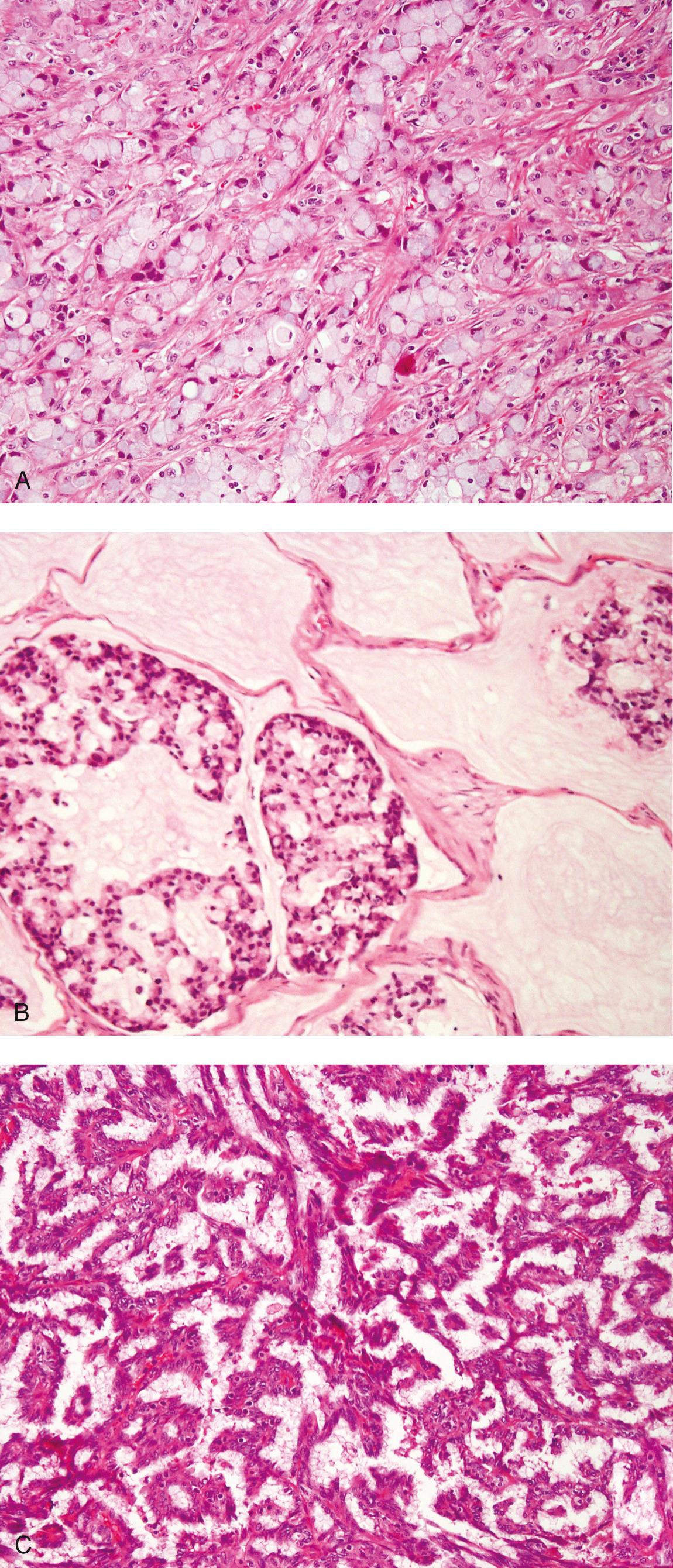
Sinonasal undifferentiated carcinoma (SNUC) is defined as a high-grade malignant epithelial neoplasm without light microscopic evidence of squamous or glandular differentiation. Although the histogenesis of these tumors is uncertain, they are thought to arise from the Schneiderian epithelium or nasal ectoderm. Histologically these tumors are composed of solid sheets and nests of high-grade pleomorphic cells with inconspicuous to prominent nucleoli, abundant mitoses, and necrosis ( Fig. 5.36 ). Although immunohistochemistry is neither specific nor pathognomonic, it plays a role in eliminating other diagnostic entities, such as ONB and malignant melanoma. SNUCs react with a variety of cytokeratins but usually lack immunoreactivity for neuroendocrine markers (i.e., chromogranin and synaptophysin). These tumors are usually locally extensive at presentation and show a propensity toward rapid growth. Despite aggressive treatment, SNUCs have high rates of locoregional failure and distant metastases, particularly to the lungs and bone. Multimodality treatment is usually recommended, including surgery, radiation, and chemotherapy, but despite aggressive treatment, prognosis remains poor.
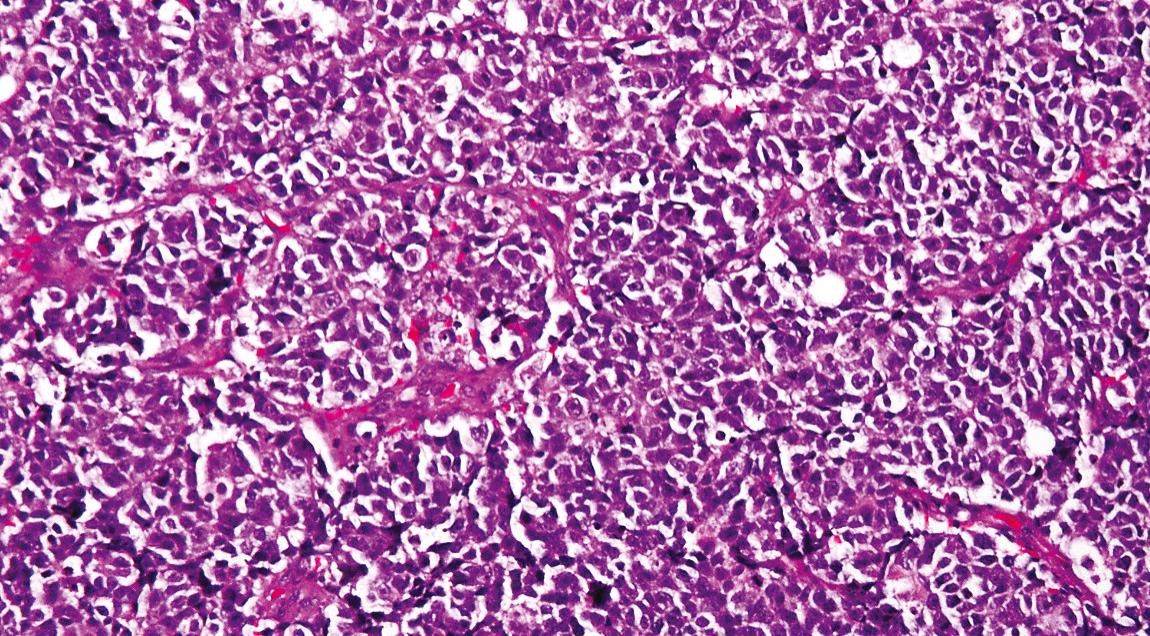
The nasal cavity is the most common site for mucosal melanomas in the head and neck. Mucosal melanomas are less commonly pigmented than are their cutaneous counterparts. Two clinical variants are seen: nodular and mucosal multifocal. The cells of this malignant neoplasm are less cohesive than in a carcinoma. The presence of in situ melanoma is essential to differentiate a primary mucosal melanoma from a metastatic lesion. Another clue to the diagnosis is the presence of the prominent nucleoli within the nuclei ( Fig. 5.37 ).
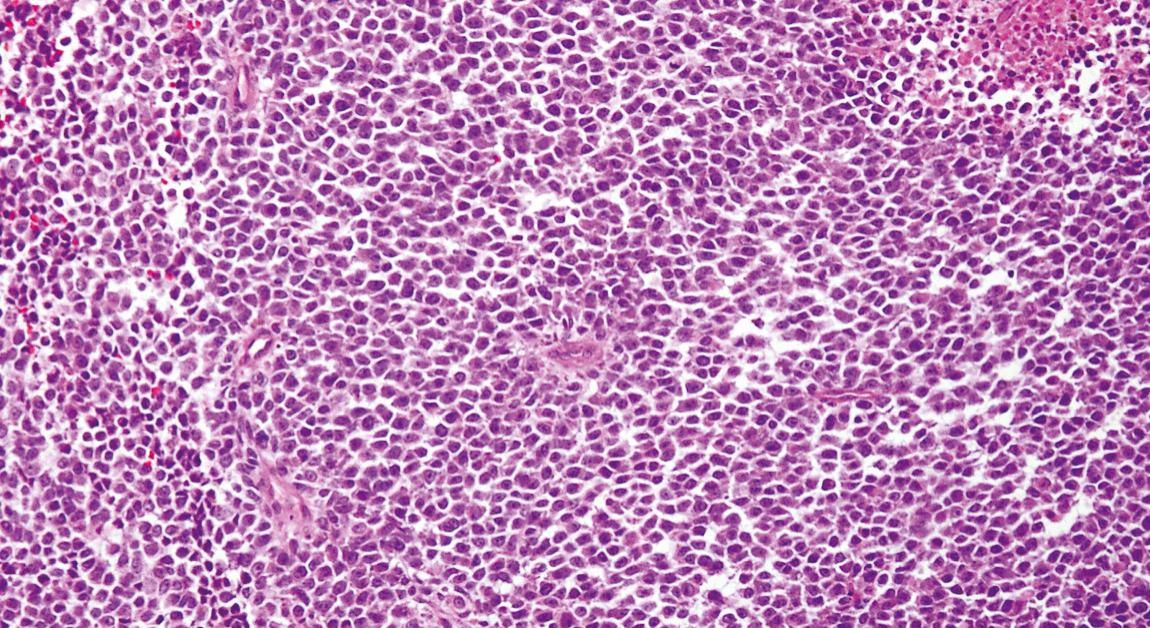
Because of the bony confines of the paranasal sinuses and the proximity of vital structures such as the orbit and brain, external irradiation is not considered as a preferred definitive treatment modality for primary malignant tumors arising in this region. Surgical resection thus remains the initial treatment of choice for most tumors of the nasal cavity and paranasal sinuses, although induction chemotherapy and concurrent chemoradiation therapy may be considered for very advanced tumors preoperatively and for selected histologies such as SNUC. Lesions staged as T4b are considered unresectable, and radiation with chemotherapy may be employed as definitive treatment. A systematic approach is therefore essential in proper selection of an appropriate surgical procedure, whether endoscopic or open, for adequate resection of early and advanced tumors of the nasal cavity and paranasal sinuses. These considerations involve invasion of the skin, bones (such as frontal, nasal, clivus, maxilla, hard palate), orbit, cavernous sinus, brain, and carotid artery. Surgical treatment alone is considered appropriate for nearly all benign tumors and early staged malignant tumors amenable to a curative surgical resection with negative margins.
A contraindication to surgical intervention for advanced tumors of the nasal cavity and paranasal sinuses includes the presence of trismus resulting from invasion of the pterygoid muscles and soft tissues in the masticator space around the temporomandibular joint and the pterygomaxillary fossa. Invasion of the skull base with bone destruction of the posterosuperior wall and the lateral walls of the sphenoid sinus also is considered a contraindication for surgical intervention. Similarly, significant brain invasion, invasion of the cavernous sinus with cranial nerve paralysis, (CN II, III, IV, V, or VI) and invasion of the carotid artery by a tumor are contraindications to surgical intervention.
The National Comprehensive Cancer Network (NCCN) guidelines recommend that for T1-T4a tumors, surgical resection with or without postoperative radiation or chemoradiotherapy is the standard of care for malignant sinonasal tumors. However, alternative approaches have been shown to be efficacious in selected cases. Concurrent treatment with systemic chemotherapy and radiotherapy (intensity-modulated radiotherapy) has shown promising results for the management of some sinonasal malignancies. The advent of proton beam radiation treatment has enabled the administration of an appropriate target dose to the tumor with a decreased dose to collateral tissue. The use of proton radiation is becoming more steadily adopted in the United States for sinonasal and skull base malignancy. The chemotherapeutic drugs currently being used include a combination of cisplatinum, 5-fluorouracil (5-FU), and Taxotere, in a variety of dosage schedules. Patients who are unable to tolerate cisplatinum are candidates for treatment with carboplatinum. High doses of intraarterial cisplatin given selectively through the vessels feeding the tumor along with an intravenous infusion of a neutralizing agent (sodium thiosulfate) and concomitant radiotherapy have been reported by some authors to be effective in the treatment of advanced sinonasal malignancies. This approach is suggested to decrease systemic toxicity while increasing locoregional control. Targeted therapies with anti–epidermal growth factor receptor and anti–vascular endothelial growth factor agents in combination with or without other cytotoxic agents and radiotherapy are currently under investigation. Similarly, immunotherapeutic agents such as PD 1 and PDL 1 inhibitors are currently being tested in clinical trials.
The nasal cavity is the inlet to the upper airway, beginning at the anterior nares and ending at the posterior choanae that open into the nasopharynx. It provides a portal of entry that filters, humidifies, and warms incoming air on its way to the lungs. The nasal cavity is divided in the midline by the nasal septum, which is composed of the septal cartilage and the vomer bone, covered on each side by the nasal mucosa. The lateral walls of the nasal cavity are partly cartilaginous and partly bony, and its floor is purely bony. Laterally, the nasal cavity contains the nasal conchae; the inferior concha is part of the nasal cavity, and the superior and middle conchae are composite parts of the ethmoid complex. The mucous membrane that lines the nasal cavity is densely adherent to the underlying periosteum and perichondrium. The majority of the mucous membrane is pseudostratified columnar ciliated epithelium of the Schneiderian type. The lining is highly vascular and contains mucous glands, minor salivary glands, and melanocytes. The olfactory neuroepithelium that is responsible for the sense of smell overlies the cribriform plate in the roof of the nasal cavity and is less vascular compared with the remainder of the mucosa. The lateral nasal wall bears the conchae or turbinates, and the meati or air spaces between them contain the openings of the paranasal sinuses. The inferior meatus is located below and lateral to the inferior concha and receives the opening of the nasolacrimal duct on the anterior portion of its lateral wall. The ostium of the maxillary sinus opens into the ethmoidal infundibulum of the middle meatus, whereas the sphenoid sinus drains into the sphenoethmoidal recess above the uppermost concha. The blood supply to the nasal cavity is from branches of both the external carotid arteries (sphenopalatine branches of the internal maxillary artery and facial artery) and internal carotid arteries (anterior and posterior ethmoid branches of the ophthalmic artery). The veins of the nose arise in the dense venous plexuses that are especially concentrated on the inferior nasal concha, the inferior meatus, and the posterior septum, and the venous drainage parallels the arteries. Lymphatic drainage is primarily to the jugulodigastric nodes and the retropharyngeal nodes.
The nasal cavity is surrounded by bony spaces that are lined with mucosa and contain air, called paranasal sinuses, the largest of which are the maxillary sinuses. Ethmoid air cells occupy the superior aspect of the nasal cavity and separate it from the anterior skull base at the level of the cribriform plate. For purposes of staging malignant tumors, the lower half of the nasoethmoid region, including the inferior turbinate and concha, is considered the nasal cavity, whereas the upper half, consisting of the middle and superior turbinates and ethmoid air cells, constitutes the ethmoid region. Superoanteriorly, the frontal sinus contained within the frontal bone forms a biloculated or multiloculated pneumatic space. The sphenoid sinus at the superoposterior part of the nasal cavity is located at the roof of the nasopharynx. The sphenoid sinus is divided by a median septum and may be multiloculated. The anatomic location of the paranasal sinuses and their relationship to each other are shown in Figs. 5.38 and 5.39 .
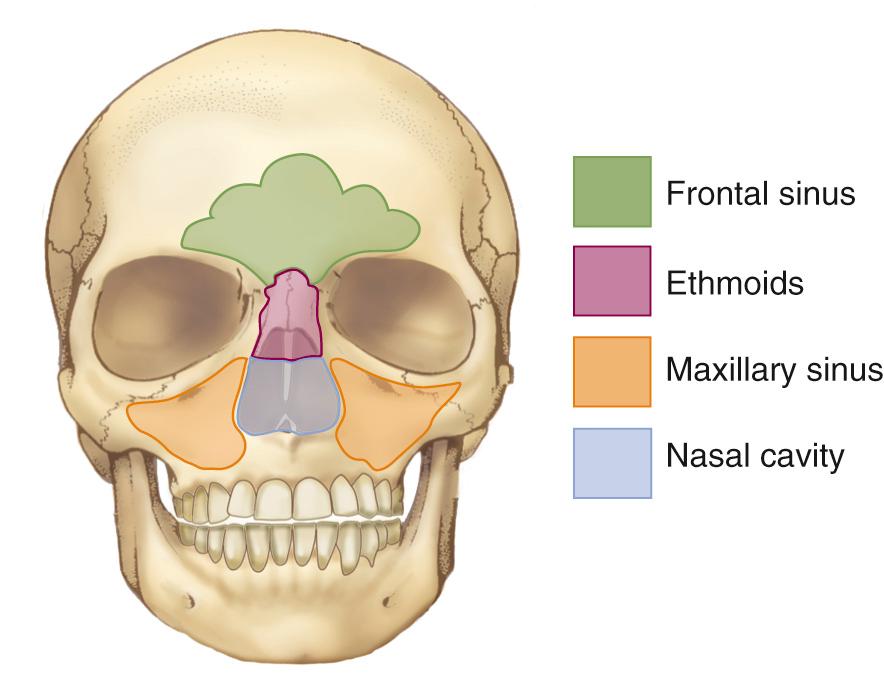
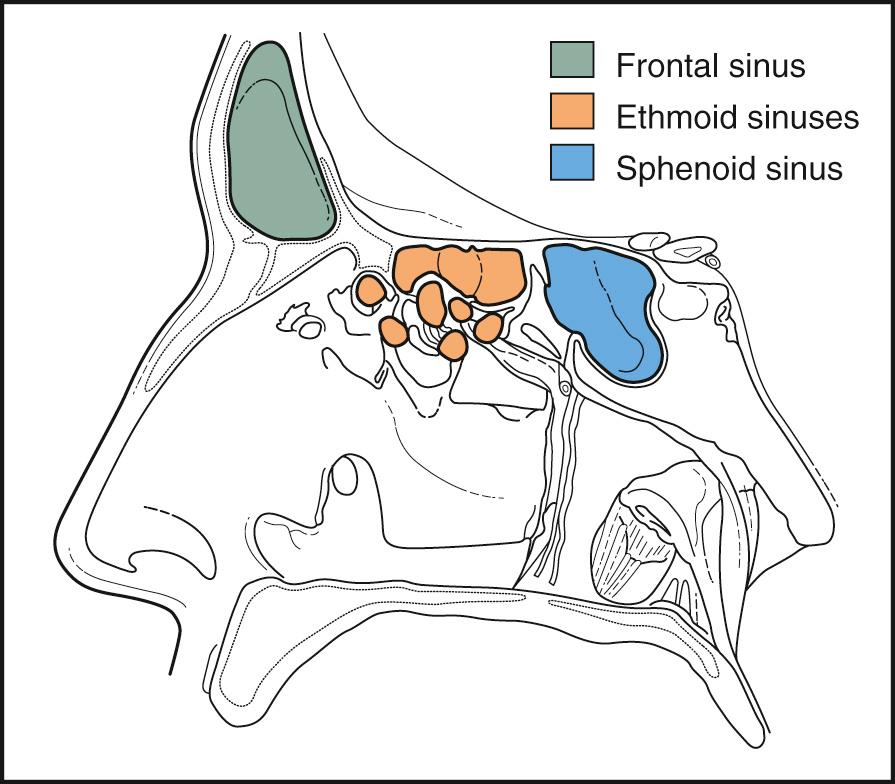
Become a Clinical Tree membership for Full access and enjoy Unlimited articles
If you are a member. Log in here